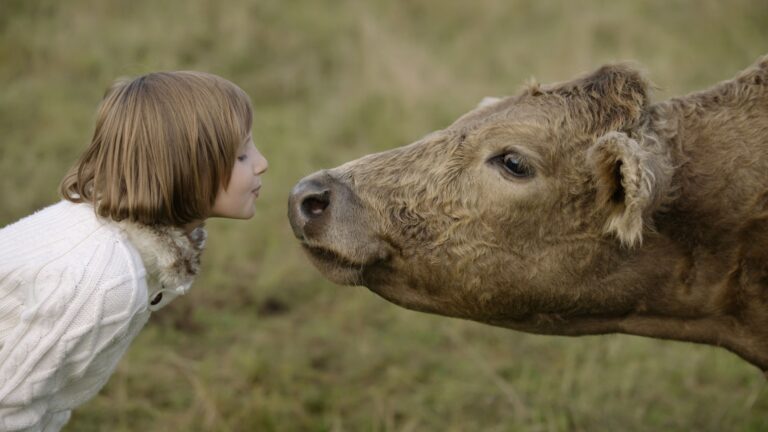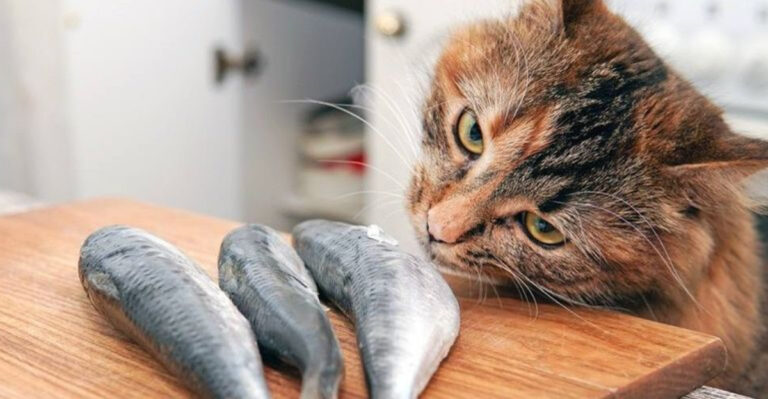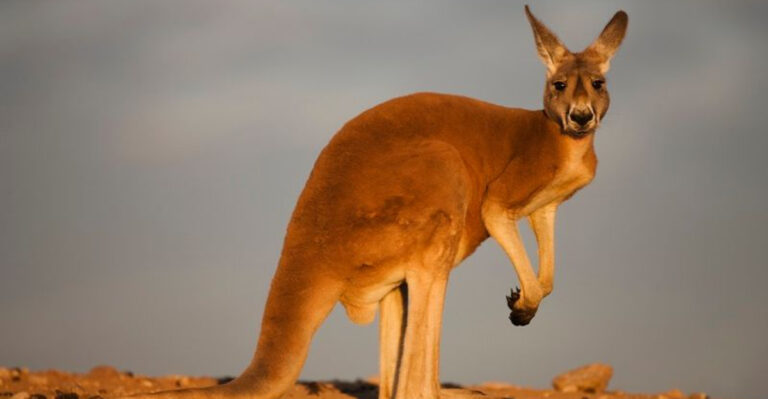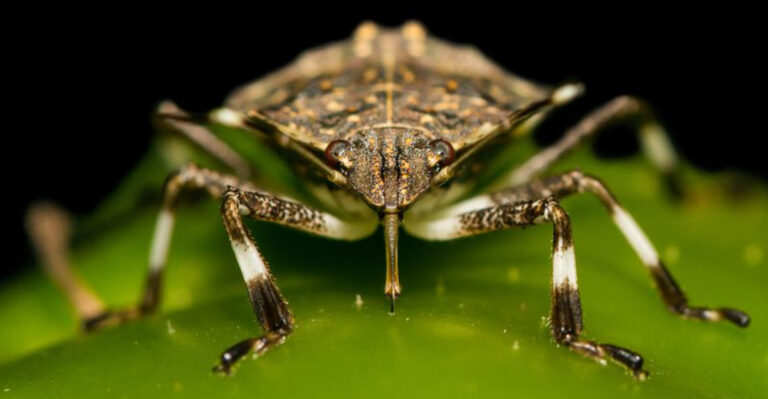These Are The Fastest Animals Ever Spotted In Every State

Every state in the United States boasts its unique wildlife, but among them, certain creatures stand out as the fastest.
From the swift-moving pronghorns of the wide plains to the darting peregrine falcons in urban skies, each state has its own speedster leaving trails of awe-stricken spectators.
This list explores these remarkable animals, bringing to light their fascinating speed capabilities and the environments they thrive in. Buckle up for a whirlwind tour of America’s fastest animals as we travel across all 50 states.
1. California – Peregrine Falcon
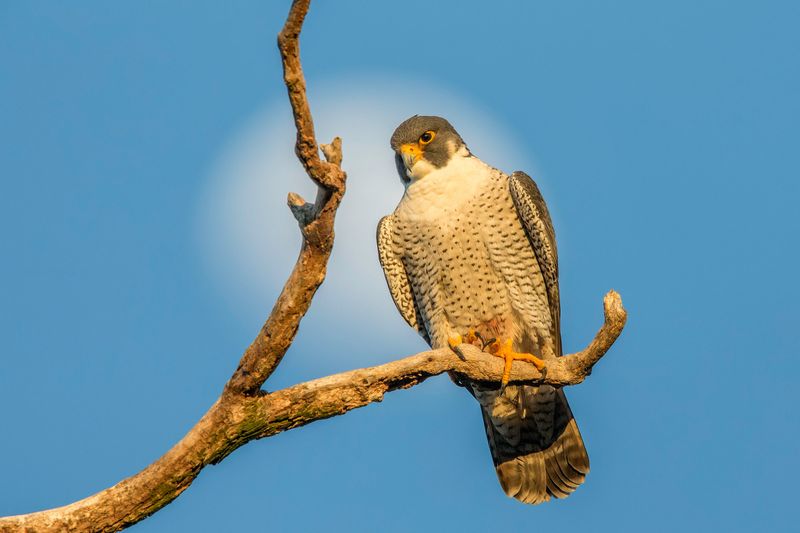
California is home to the peregrine falcon, renowned as one of the fastest birds globally. With astounding speeds that can exceed 240 mph during its hunting stoop, this bird of prey is truly a marvel of nature. Found frequently along the coastal cliffs, its swift dive to catch prey is a sight to behold.
The peregrine falcon’s streamlined body and powerful wings allow it to accelerate rapidly, making it a master of the skies. In California, these birds have adapted well to urban environments, often nesting on tall buildings and bridges.
This adaptability, combined with their incredible speed, makes them a formidable predator. Observing a peregrine falcon in action is an unforgettable experience, highlighting the raw power and grace that nature can offer. With a keen eye and unparalleled precision, it dominates the airspace, asserting its reign as the fastest animal in the state.
2. Texas – Mexican Free-Tailed Bat
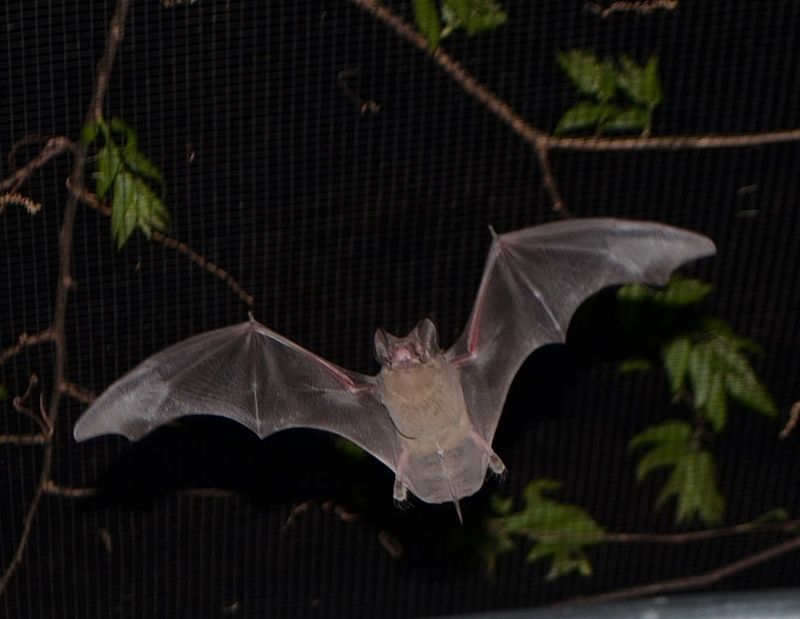
In the heart of Texas, the Mexican free-tailed bat holds the title for the fastest mammal. Capable of reaching speeds up to 99 mph, this bat is an aerial acrobat, navigating the night skies with remarkable agility.
Found in large colonies, particularly in places like the Congress Avenue Bridge in Austin, these bats emerge at dusk in a spectacular display. Their slender bodies and long tails aid in their swift flight, allowing them to cover vast distances in search of food.
As insectivores, their speed is an asset in catching elusive prey, making them essential for pest control in the region. The sight of thousands of these bats taking to the sky is a natural wonder, drawing crowds eager to witness their nightly journey. The Mexican free-tailed bat exemplifies nature’s ingenuity, blending speed and efficiency in the Texan ecosystem.
3. Florida Panther
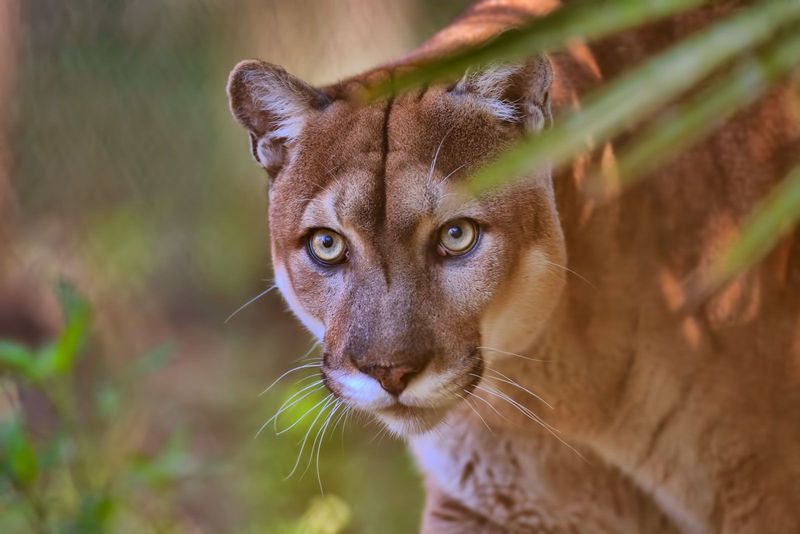
The Florida Panther, one of the fastest land animals in Florida, is known for its incredible agility and speed. Capable of reaching speeds up to 35 miles per hour, this majestic cat navigates the dense underbrush of the Everglades with remarkable skill.
Its ability to sprint quickly helps it hunt prey and avoid danger in its swampy habitat. With muscular limbs and a sleek body, the Florida Panther is an impressive example of nature’s engineering for speed. As an endangered species, conservation efforts are crucial to ensure the survival of this iconic Floridian predator.
4. Alaska – Gyrfalcon
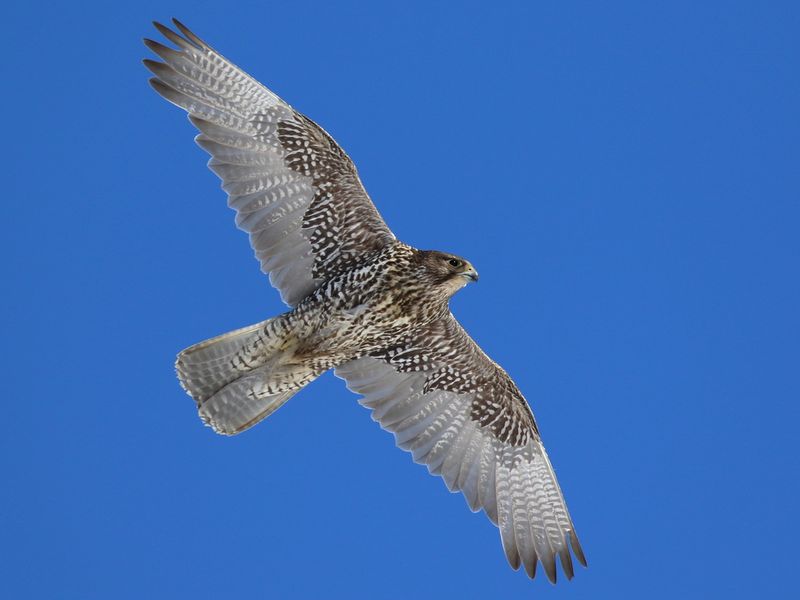
In the vast expanses of Alaska, the gyrfalcon reigns supreme in speed. As the largest falcon species, it is both powerful and swift, capable of reaching speeds over 60 mph. Its hunting grounds range from the Arctic tundra to forested valleys, where it preys on birds and small mammals.
The harsh Alaskan environment is no match for this resilient bird, which thrives in cold conditions. With its powerful flight, it patrols the skies, showcasing agility and speed that few can match. The gyrfalcon’s plumage varies from pure white to dark gray, allowing it to blend seamlessly into its surroundings.
This camouflage, coupled with its speed, makes it a versatile hunter. Observing a gyrfalcon in its natural habitat is witnessing mastery over the elements, a creature perfectly adapted to its rugged home. Its presence underscores the wild, untamed beauty of Alaska’s wilderness.
5. New York – Peregrine Falcon
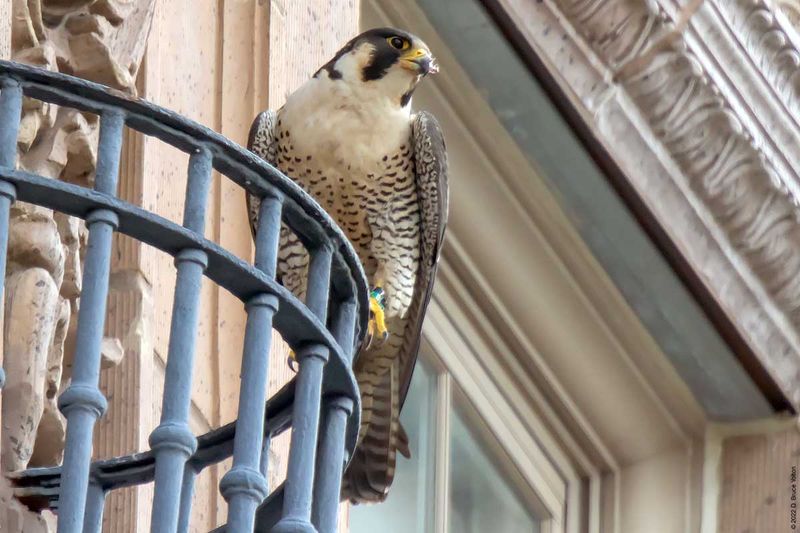
In the bustling metropolis of New York, the peregrine falcon is a symbol of urban wildlife adaptation. Renowned for its unparalleled speed, it dominates the city skyline with the fastest recorded dive at over 240 mph.
This bird of prey has adapted well to urban environments, often seen nesting on skyscrapers and bridges. Its incredible speed and agility make it a formidable hunter, preying on pigeons and other birds. The peregrine falcon’s presence in New York highlights the city’s commitment to wildlife conservation, as efforts have been made to protect and monitor these magnificent birds.
Watching a peregrine falcon dive in the concrete jungle is a thrilling spectacle, a reminder of nature’s resilience amidst human development. Its mastery of the skies illustrates a perfect blend of adaptation and speed, making it an icon of New York’s diverse wildlife.
6. Nevada – Pronghorn
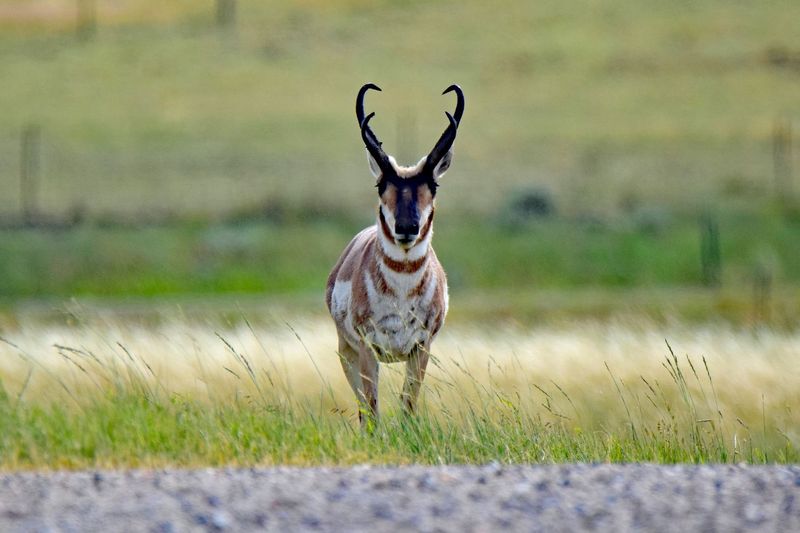
In the arid landscapes of Nevada, the pronghorn stands out as a speedster. Although not as fast as the cheetah, it is the fastest land mammal in North America, reaching speeds up to 55 mph. This remarkable speed is a survival adaptation, allowing it to outrun predators across open terrain.
The pronghorn’s unique anatomy, including large lungs and a robust heart, supports its high-speed sprints. In Nevada, these animals roam the vast deserts, their tan and white coloration blending into the sunbaked expanse.
Observing a pronghorn in motion is a testament to nature’s engineering, with every stride optimized for speed and endurance. Their presence in Nevada symbolizes the wild spirit of the desert, a creature perfectly attuned to its environment. The pronghorn’s incredible speed and agility make it a fascinating subject of study and admiration in the Silver State.
7. Colorado – Golden Eagle
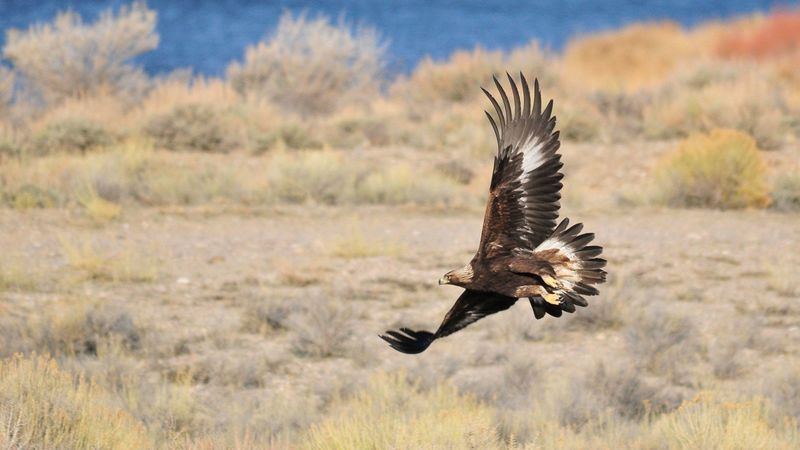
Soaring above the Colorado Rockies, the golden eagle is a majestic symbol of speed and power. With a wingspan that can exceed seven feet, this bird is capable of reaching speeds over 150 mph during its hunting stoops.
Its keen eyesight allows it to spot prey from great heights, making it a formidable predator in its mountainous habitat. The golden eagle’s mastery of the air is unparalleled, as it uses thermal updrafts to glide effortlessly across vast distances. In Colorado, these eagles are often seen commanding the skies, their golden plumage shimmering in the sunlight.
Observing a golden eagle in flight is a breathtaking experience, encapsulating the grandeur of the natural world. Their presence in the Rockies is a testament to the state’s rich biodiversity, offering a glimpse into the wild majesty of Colorado’s landscapes. The golden eagle embodies the essence of untamed wilderness.
8. Arizona – Roadrunner
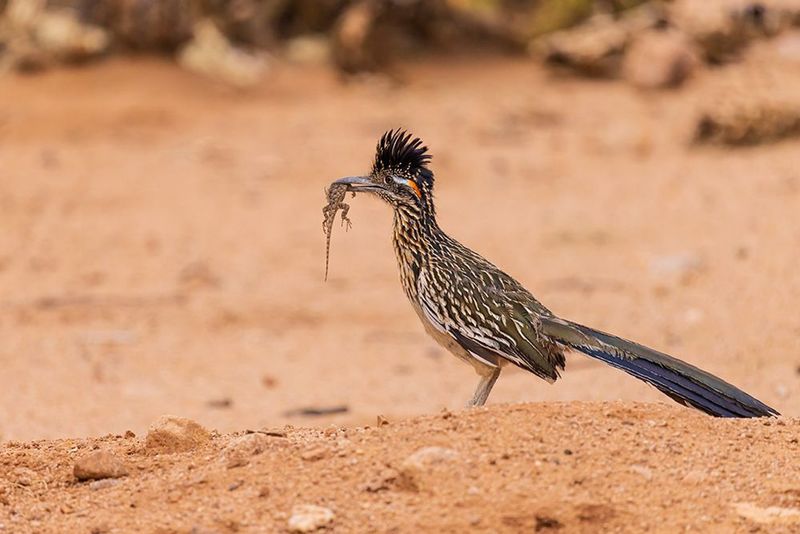
In the sun-drenched deserts of Arizona, the roadrunner is an icon of speed and agility. Known for its ability to run at speeds up to 20 mph, it is a bird uniquely adapted to its arid environment.
The roadrunner’s long legs and tail provide balance and speed on the ground, allowing it to chase down prey like insects and small reptiles. Despite its comical portrayal in popular media, the roadrunner is a skilled hunter, using its quick reflexes to capture prey.
Its distinctive crest and streaked plumage offer camouflage among desert shrubs, aiding in its survival. The roadrunner’s presence in Arizona showcases nature’s ingenuity, a bird perfectly adapted to life in the desert.
Watching a roadrunner in action evokes a sense of wonder, as it embodies the spirit of the wild west. Its speed and resourcefulness make it a beloved symbol in the Grand Canyon State.
9. Michigan – Eastern Coyote
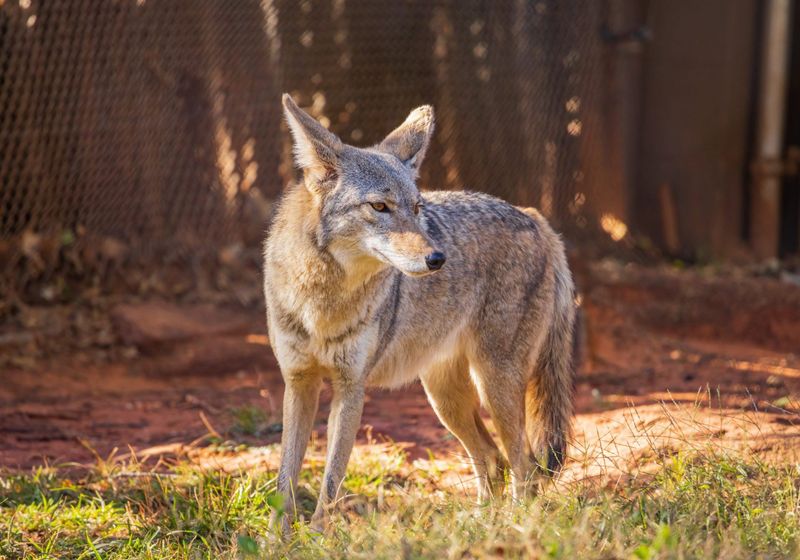
The Eastern Coyote, a prevalent sight in Michigan, is a master of both speed and endurance. Capable of running up to 40 mph, these resilient canines have adapted well to varied environments, from rural to urban settings.
Their long, lean bodies and strong legs contribute to their remarkable speed. Eastern Coyotes are opportunistic hunters, employing both stealth and speed to capture prey ranging from small rodents to deer.
Their ability to cover large distances quickly makes them efficient predators and scavengers. In the winter, their speed is particularly advantageous as they navigate the snow-covered terrains of Michigan. The Eastern Coyote’s adaptability and swiftness are key to its survival and success in the region’s challenging climate.
10. Minnesota – Timber Wolf
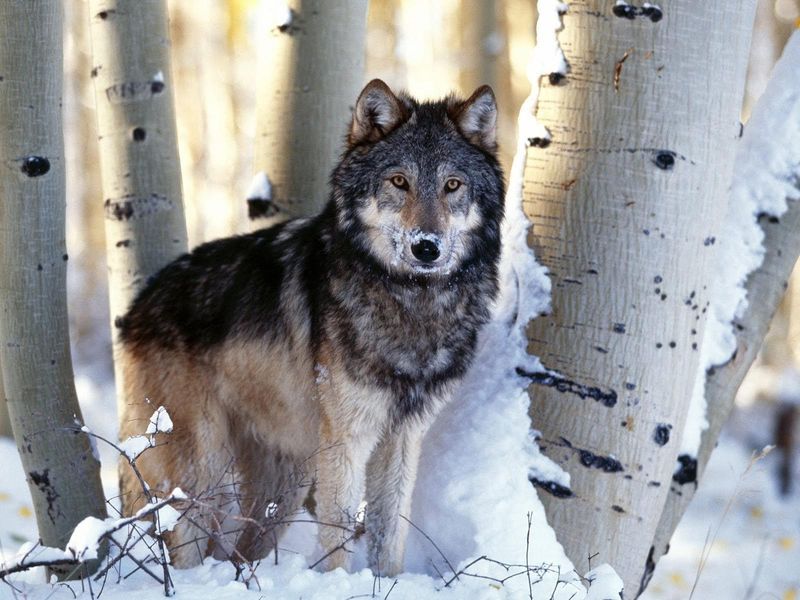
In the dense forests of Minnesota, the timber wolf exemplifies speed and endurance. Capable of running at speeds up to 37 mph, this apex predator is both swift and stealthy. The timber wolf’s powerful legs and lean body allow it to cover great distances, vital for hunting and territory defense.
In Minnesota, these wolves roam the wild expanses, their howls echoing through the woods. Their thick fur provides insulation against the harsh winters, while their sharp senses make them formidable hunters. Observing a timber wolf in its natural habitat is an experience that underscores the wild spirit of the region.
These wolves play a crucial role in maintaining the ecological balance, preying on deer and other ungulates. The timber wolf’s presence in Minnesota is a symbol of the untamed wilderness and the enduring power of nature. Their speed and tenacity are admired and respected throughout the state.
11. North Dakota – Mule Deer
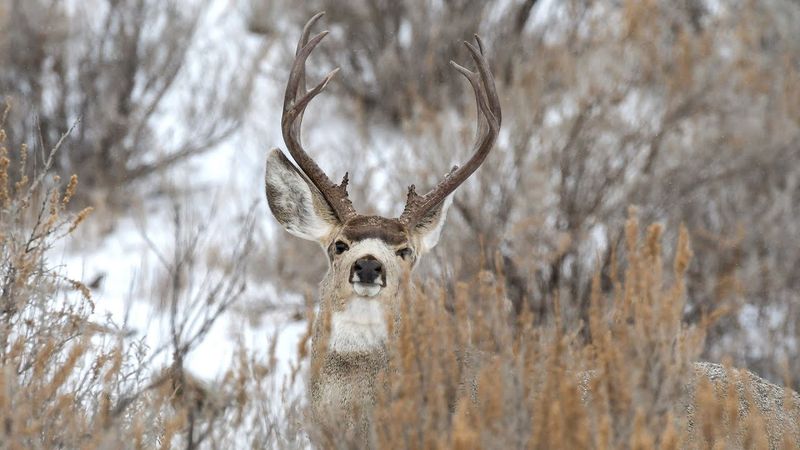
On the vast plains of North Dakota, the mule deer is recognized for its agility and speed. With the ability to reach speeds up to 45 mph, it uses its powerful legs to evade predators. The mule deer’s distinctive large ears and strong hindquarters are key adaptations that aid in its swift movements.
In North Dakota, these deer are often seen bounding across open fields, their graceful leaps a testament to their speed. Their brown-gray coats provide camouflage in the grasslands, helping them blend into the landscape.
The mule deer’s agility is not only crucial for survival but is also a beautiful display of nature’s prowess. Observing mule deer in action reveals the intricate balance of predator and prey interactions in the region. Their presence highlights the rich biodiversity of North Dakota, where speed and agility are vital traits for the wildlife that call this place home.
12. Montana – Elk
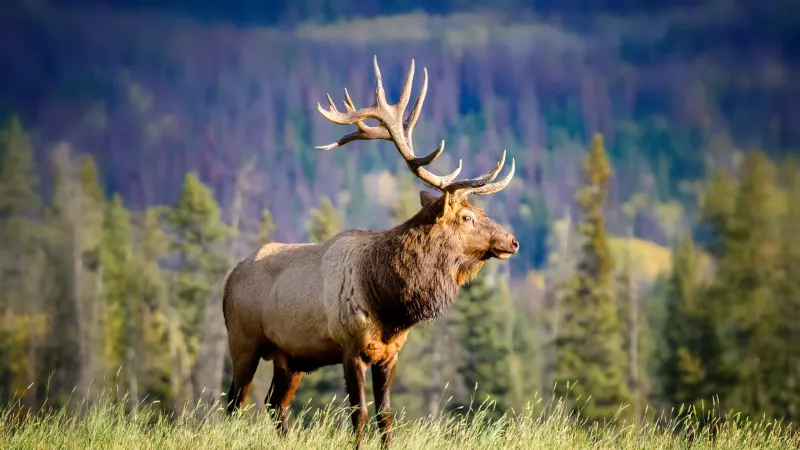
In the sprawling wilderness of Montana, the elk is a creature of power and speed. Capable of reaching speeds up to 45 mph, this large mammal is both impressive and graceful. The elk’s powerful build and long legs allow it to cover significant distances, essential for escaping predators and migrating across its vast habitat.
In Montana, elk are a common sight in forests and grasslands, their bugling calls echoing through the valleys. Their antlers, a symbol of strength, add to their majestic presence in the wild. Observing an elk in motion is a remarkable experience, showcasing the raw power and agility of this magnificent animal.
Their role in the ecosystem is essential, as they graze on vegetation and serve as prey for large predators. The elk’s speed and endurance make it a fascinating subject for wildlife enthusiasts, embodying the spirit of the Montana wilderness.
13. Idaho – Coyote
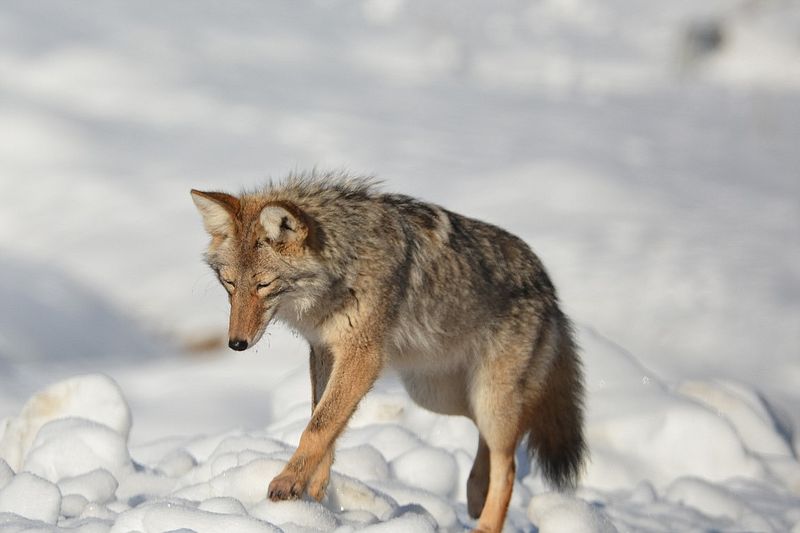
In the diverse landscapes of Idaho, the coyote is a master of speed and cunning. Capable of reaching speeds up to 43 mph, this adaptable predator roams the state’s forests and plains with stealthy grace. The coyote’s lean body and sharp senses make it an efficient hunter, preying on small mammals and birds.
In Idaho, coyotes play a crucial role in maintaining ecological balance, controlling populations of rodents and other animals. Their adaptability to various environments is a testament to their resilience and intelligence.
Observing a coyote in its natural habitat is a lesson in survival, showcasing nature’s ingenuity in evolution. The coyote’s presence is both respected and admired, embodying the wild essence of Idaho’s landscapes. As a symbol of adaptability and endurance, the coyote continues to thrive despite the challenges of changing environments, making it an integral part of the state’s wildlife.
14. Wyoming – Pronghorn
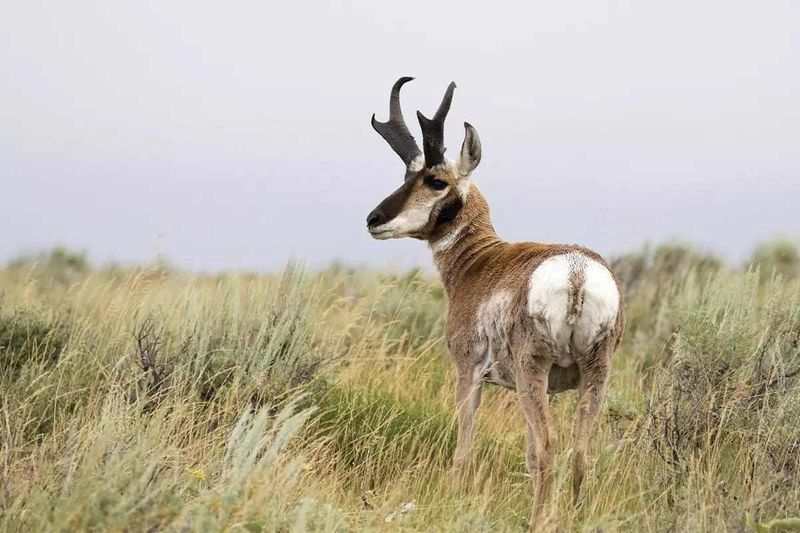
In Wyoming’s expansive prairies, the pronghorn is celebrated for its remarkable speed. Second only to the cheetah, this agile creature can reach speeds up to 55 mph, the fastest in North America. The pronghorn’s incredible speed is an evolutionary advantage, helping it evade predators in the wide-open spaces.
Its unique anatomy, characterized by large lungs and a robust cardiovascular system, supports swift, sustained sprints. In Wyoming, pronghorns are a common sight, their tan and white coats blending with the rolling landscape.
Observing a pronghorn in full stride is a mesmerizing experience, highlighting nature’s engineering at its best. Their role in the ecosystem is vital, as they graze on native grasses and serve as prey for larger carnivores.
The pronghorn’s speed and grace make it a symbol of the untamed beauty of Wyoming’s wilderness, captivating all who witness its fleeting elegance.
15. Utah – Bald Eagle
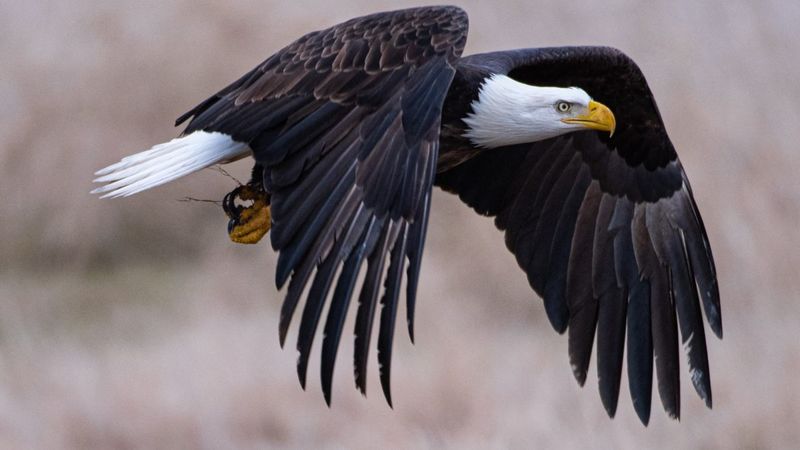
In the skies over Utah, the bald eagle commands attention with its speed and majesty. Capable of reaching speeds up to 100 mph during hunting dives, this bird of prey is a powerful presence. The bald eagle’s distinctive appearance, with its white head and tail, makes it a recognizable symbol of strength and freedom.
In Utah, these eagles are often seen near large bodies of water, where they hunt for fish and waterfowl. Their impressive wingspan, up to seven feet, allows them to glide effortlessly across vast distances. Observing a bald eagle in flight is an awe-inspiring experience, a reminder of the wild freedom of the skies.
Their presence highlights the importance of conservation efforts to protect these majestic birds. The bald eagle’s speed and precision in hunting make it an admired and respected symbol of the natural world, embodying the spirit of Utah’s wild landscapes.
16. Oregon – Black-Tailed Deer
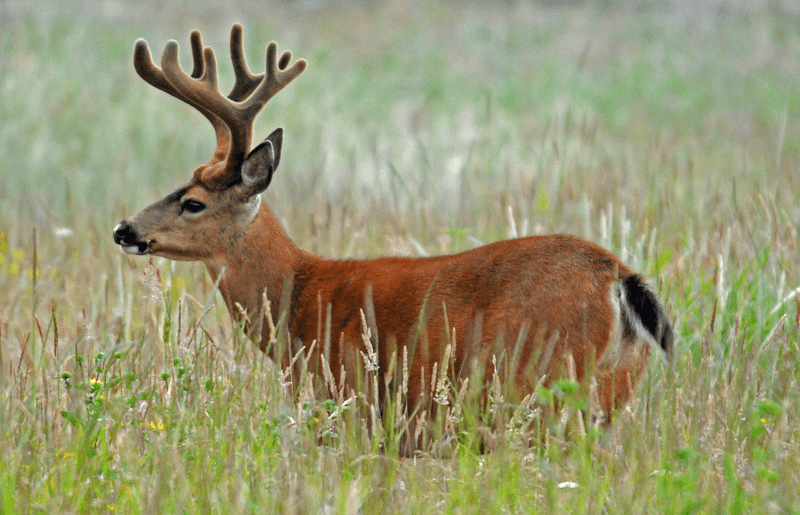
In Oregon’s lush forests, the black-tailed deer is a study in speed and agility. Capable of reaching speeds up to 45 mph, this deer is adept at navigating the dense underbrush with ease. The black-tailed deer’s powerful legs and keen senses are essential for evading predators and foraging for food.
In Oregon, these deer are frequently seen bounding through forests and meadows, their grace and speed a natural spectacle. Their dark, distinctive tails and reddish-brown coats provide camouflage in the varied landscapes, aiding in their survival.
Observing a black-tailed deer in its natural habitat is a glimpse into the delicate balance of nature, where speed is both a defense and a way of life. Their role in the ecosystem is vital, as they browse on vegetation and are prey for large carnivores. The black-tailed deer’s speed and agility highlight the dynamic beauty of Oregon’s wilderness.
17. Washington – Orca
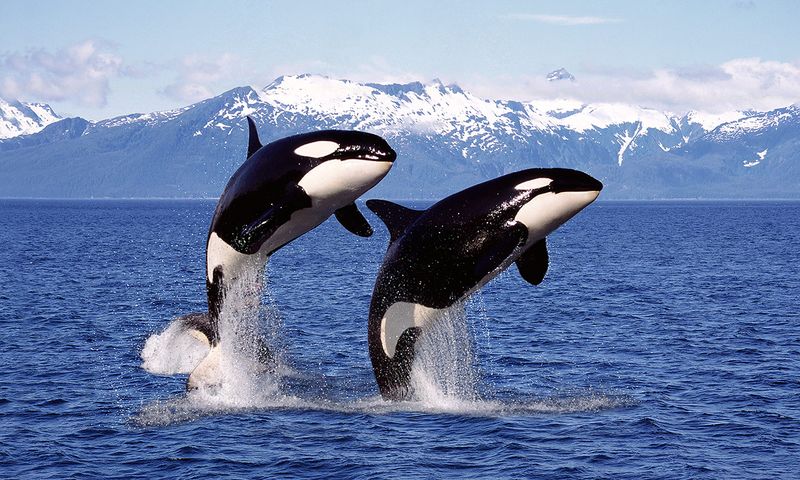
Off the coast of Washington, the orca is a magnificent symbol of power and speed in the ocean. Capable of reaching speeds up to 34 mph, these apex predators dominate the marine environment. The orca’s sleek, black-and-white body is built for speed and agility, allowing it to hunt effectively in the waters of Puget Sound.
In Washington, orcas are a familiar sight, their impressive breaches and synchronized swimming captivating audiences. These intelligent creatures exhibit sophisticated social behavior, hunting in pods and communicating through complex vocalizations.
Observing an orca in its natural habitat is an unforgettable experience, a testament to the beauty and power of marine life.
Their presence underscores the importance of conserving marine ecosystems to protect these incredible animals. The orca’s speed and grace in the water make it a beloved icon of Washington’s rich coastal heritage, inspiring awe and respect.
18. Hawaii – Spinner Dolphin
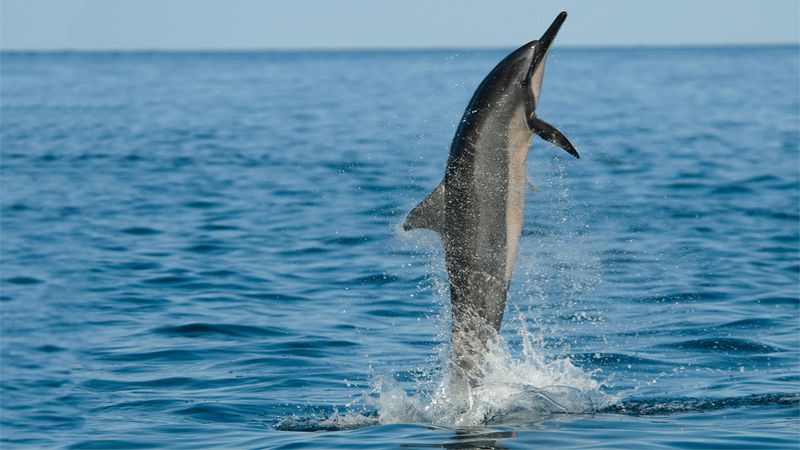
In the warm waters of Hawaii, the spinner dolphin is a marvel of speed and agility. Known for its acrobatic leaps and spins, this dolphin can reach speeds up to 25 mph. The spinner dolphin’s sleek body and powerful tail propel it through the ocean with ease, making it a skilled hunter and playful performer.
In Hawaii, these dolphins are often seen near coastal areas, delighting onlookers with their aerial antics. Their social nature and intelligence are evident in their complex behaviors, as they travel in pods and communicate with a variety of sounds.
Observing spinner dolphins in their natural habitat is a magical experience, capturing the joy and wonder of the ocean.
Their presence is a reminder of the rich marine biodiversity of Hawaii, where conservation efforts aim to protect these enchanting creatures. The spinner dolphin’s speed and playful spirit make it a cherished part of Hawaii’s underwater world.
19. New Mexico – Roadrunner
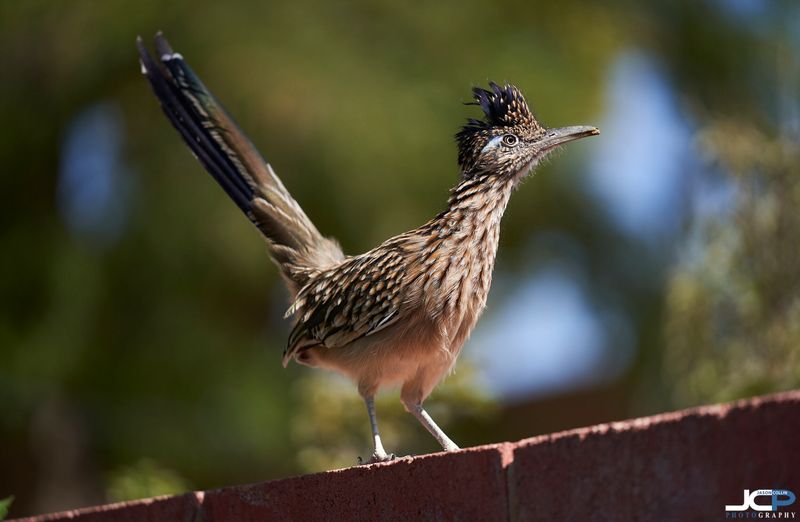
In the arid landscapes of New Mexico, the roadrunner is a swift and resourceful bird. Known for its speed, it can run at up to 20 mph, making it one of the fastest birds on land. The roadrunner’s long legs and tail provide balance and speed, allowing it to chase down insects, lizards, and small prey with remarkable agility.
In New Mexico, these birds are a common sight, their distinctive appearance and behavior adding to the state’s unique wildlife. The roadrunner’s adaptability to desert life is a testament to its resilience, thriving in harsh conditions with limited resources.
Observing a roadrunner in its natural habitat offers a glimpse into the wonders of desert ecology, where speed and cunning are essential for survival. Its presence in New Mexico is a symbol of the state’s vibrant natural heritage, embodying the spirit of the wild and untamed desert.
20. Oklahoma – American Bison
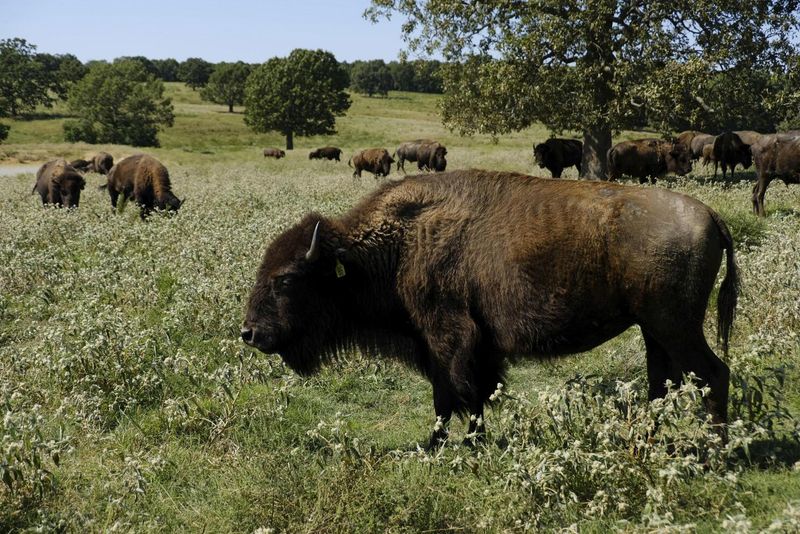
On the vast plains of Oklahoma, the American bison is a symbol of strength and speed. Despite its massive size, this iconic animal can run at speeds up to 35 mph, showcasing surprising agility. The bison’s powerful build and muscular legs enable it to charge across the open landscape, an impressive sight in the wild.
In Oklahoma, bison are a vital part of the ecosystem, grazing on grasses and maintaining the health of the prairie. Their presence is a reminder of the state’s rich natural history and the conservation efforts to preserve these majestic creatures.
Observing a bison in motion is a humbling experience, highlighting the raw power of nature. Their ability to move swiftly despite their size is a testament to their resilience and adaptability. The American bison’s speed and strength make it an enduring symbol of the American frontier, deeply ingrained in Oklahoma’s cultural heritage.
21. Louisiana – White-Tailed Deer
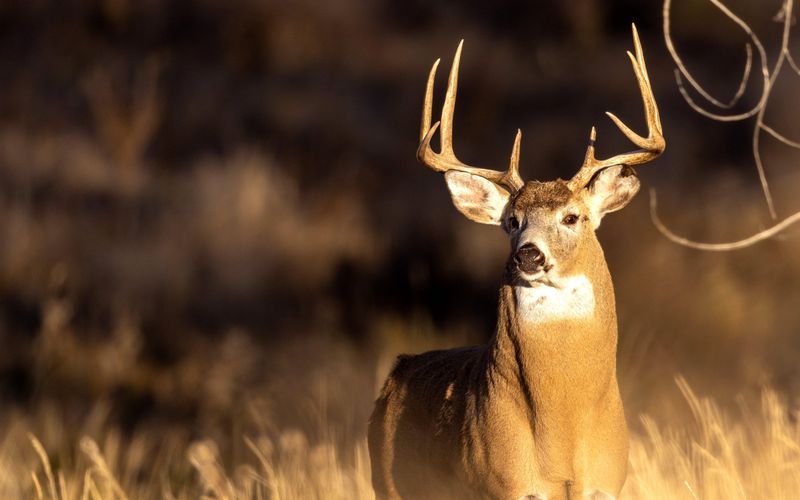
In the rich ecosystems of Louisiana, the white-tailed deer is a testament to agility and speed. Capable of reaching speeds up to 40 mph, this deer navigates the swampy terrain with ease. The white-tailed deer’s powerful legs and acute senses make it a master of its environment, evading predators and foraging for food.
In Louisiana, these deer are a common sight in forests and wetlands, their white tails flashing as they move through the underbrush. Their presence is vital for the health of the ecosystem, as they help control plant growth and provide prey for larger predators.
Observing a white-tailed deer in motion reveals the delicate balance of nature, where speed is both a defense mechanism and a means of survival. Their agility and grace highlight the dynamic beauty of Louisiana’s natural landscapes, making the white-tailed deer a cherished symbol of the state’s wildlife.
22. Alabama – Red Fox
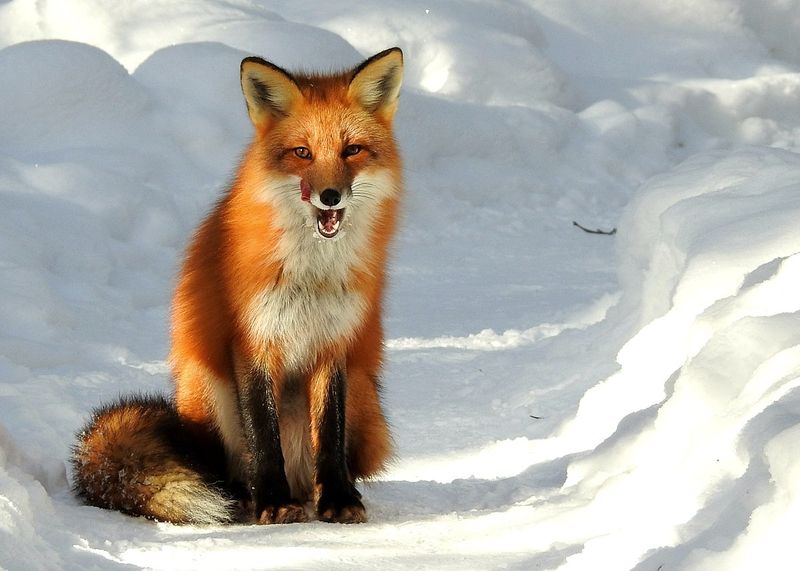
In the woodlands of Alabama, the red fox is a symbol of speed and cunning. Capable of reaching speeds up to 29 mph, this agile predator uses its swiftness to hunt small mammals and birds.
The red fox’s striking red coat and bushy tail provide camouflage among the forest’s foliage, aiding in its stealthy approach. In Alabama, these foxes are a common sight, their keen senses and adaptability allowing them to thrive in various environments.
Observing a red fox in its natural habitat is a lesson in survival, showcasing the intricate balance of predator and prey. Their speed is not only crucial for hunting but also for evading larger predators.
The red fox’s presence in Alabama highlights the importance of preserving natural habitats to maintain biodiversity. Their grace and agility make them a fascinating subject for wildlife enthusiasts, embodying the wild spirit of the state’s landscapes.
23. Georgia – Eastern Diamondback Rattlesnake
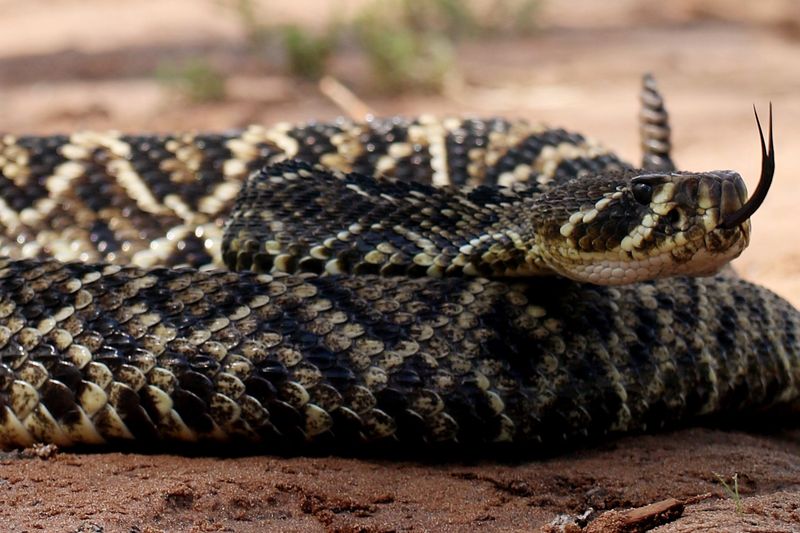
In the forests of Georgia, the Eastern diamondback rattlesnake is a creature of stealth and speed. Known for its ability to strike quickly, this venomous snake can move at speeds up to 12 mph when threatened. The Eastern diamondback’s distinctive diamond-shaped patterns and rattling tail make it easily recognizable, warning predators of its presence.
In Georgia, these snakes are found in pine forests and coastal habitats, where they hunt rodents and small mammals. Observing a rattlesnake in its natural environment is a reminder of the delicate balance in nature, where speed and defense mechanisms are crucial for survival.
Their presence highlights the need for respecting wildlife and maintaining safe distances in their habitats. The Eastern diamondback rattlesnake’s speed and agility make it an important apex predator, playing a vital role in controlling rodent populations.
Its presence in Georgia underscores the state’s rich biodiversity and the complex interactions within its ecosystems.
24. Mississippi – Wild Turkey
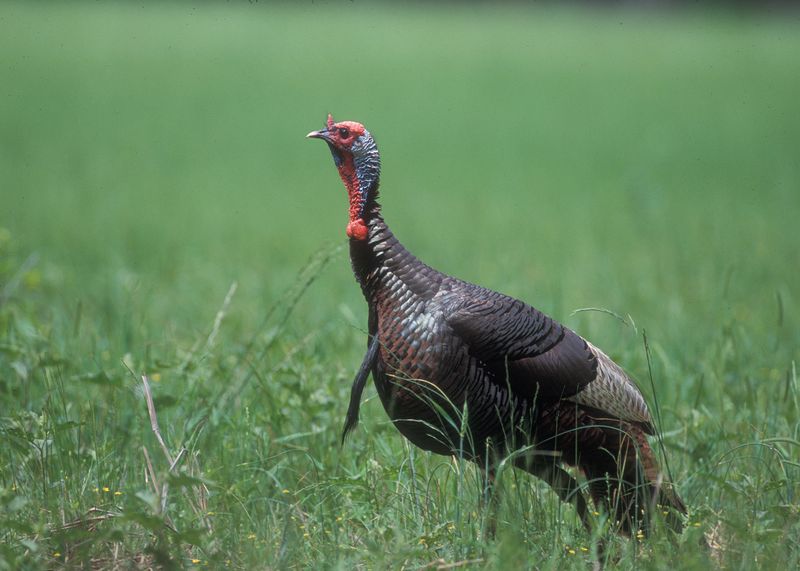
In the woodlands of Mississippi, the wild turkey is known for its surprising speed and agility. Capable of running at speeds up to 20 mph, this bird is adept at evading predators and navigating the forest floor. The wild turkey’s strong legs and keen eyesight make it a vigilant bird, always alert to its surroundings.
In Mississippi, these birds are a common sight, their distinctive plumage and calls echoing through the woods. The presence of wild turkeys is vital for the ecosystem, as they help spread seeds and control insect populations.
Observing a wild turkey in its natural habitat is a glimpse into the intricate balance of nature, where speed and awareness are essential for survival.
Their role in the environment highlights the importance of biodiversity and conservation efforts. The wild turkey’s speed and resourcefulness make it a cherished symbol of Mississippi’s rich natural heritage, captivating both hunters and wildlife enthusiasts alike.
25. Kentucky – Thoroughbred Horse
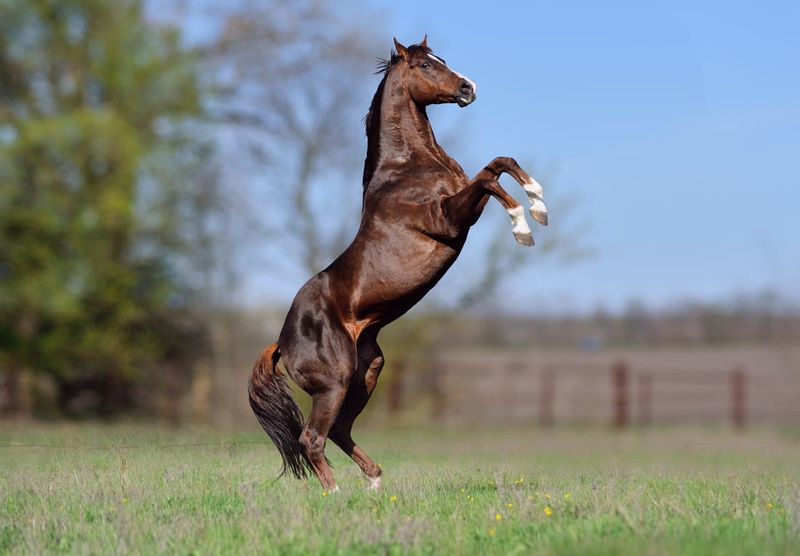
In Kentucky, the thoroughbred horse is an icon of speed and grace. Known for its racing prowess, a thoroughbred can reach speeds up to 44 mph, making it one of the fastest horses globally. Kentucky’s rich tradition of horse racing is centered around these elegant animals, with events like the Kentucky Derby drawing international attention.
The thoroughbred’s powerful build and competitive spirit are celebrated in the state’s cultural heritage. Observing a thoroughbred in full gallop is a thrilling experience, showcasing the peak of equine athleticism.
Their presence in Kentucky is not only a symbol of racing excellence but also a vital part of the local economy and tourism.
The thoroughbred horse’s speed and elegance make it a beloved figure in Kentucky, inspiring admiration and respect. Their legacy continues to shape the state’s identity, blending tradition with the thrill of high-speed competition.
26. Tennessee – Eastern Grey Squirrel
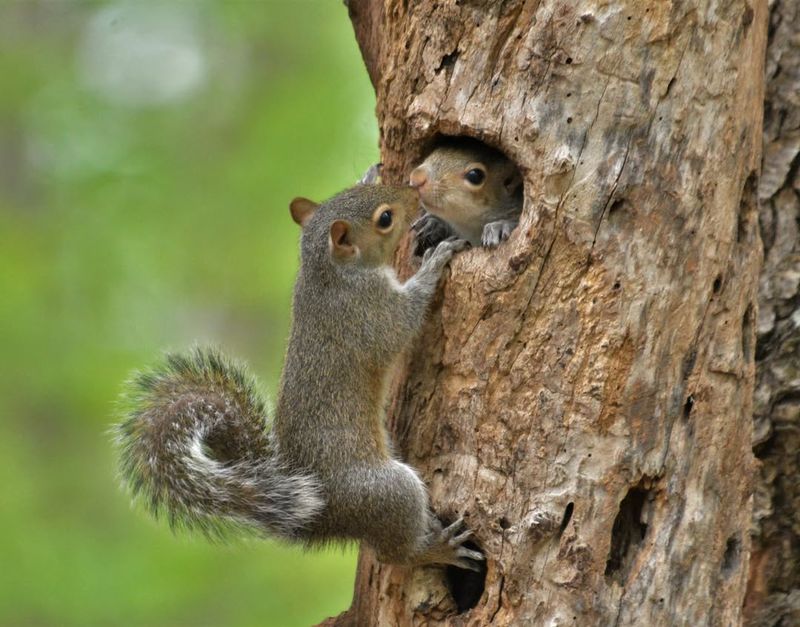
In the forests of Tennessee, the eastern grey squirrel is a lively symbol of speed and agility. Capable of reaching speeds up to 20 mph, this small mammal is a master of acrobatics among the trees. The eastern grey squirrel’s powerful hind legs and keen senses enable it to leap significant distances, evading predators and gathering food.
In Tennessee, these squirrels are a common sight, their playful antics and bushy tails adding charm to the natural landscape. Observing an eastern grey squirrel in its natural habitat is a lesson in agility, showcasing nature’s adaptability and resourcefulness.
Their speed is not only for escaping threats but also for storing food and building nests. The presence of eastern grey squirrels highlights the importance of maintaining healthy forest ecosystems, where they play a crucial role in seed dispersal.
Their quick movements and curious nature make them a delightful part of Tennessee’s wildlife.
27. Indiana – Coyote
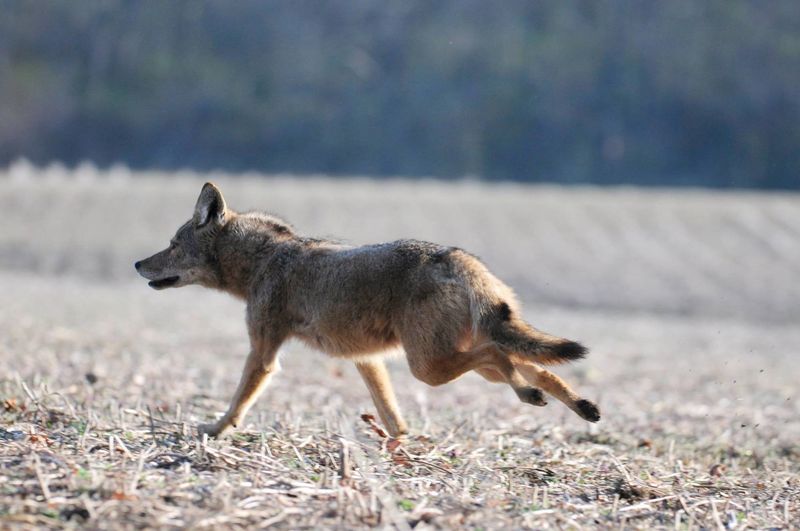
In the diverse landscapes of Indiana, the coyote is known for its remarkable speed and adaptability. Capable of reaching speeds up to 43 mph, this cunning predator navigates the state’s fields and forests with ease.
The coyote’s lean build and keen senses make it a proficient hunter, preying on small mammals and birds. In Indiana, coyotes play a vital role in controlling rodent populations and maintaining ecological balance. Their ability to thrive in various environments is a testament to their resilience and intelligence.
Observing a coyote in its natural habitat is a glimpse into the complex web of life, where speed and cunning are essential for survival.
The coyote’s presence in Indiana is both respected and admired, embodying the wild essence of the state’s landscapes. As a symbol of adaptability and endurance, the coyote continues to thrive, making it an integral part of Indiana’s wildlife heritage.
28. Ohio – Red Fox
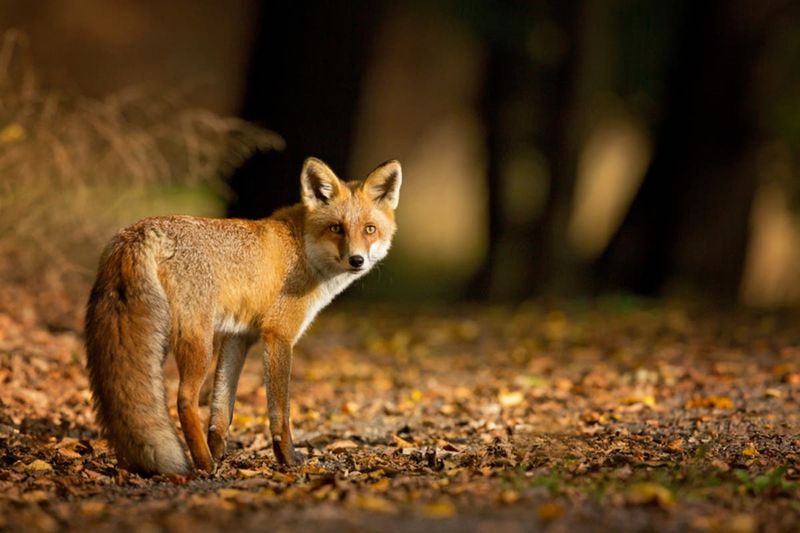
In the woodlands of Ohio, the red fox is a symbol of speed and cunning. Known for its ability to reach speeds up to 29 mph, this agile predator uses its swiftness to hunt small mammals and birds. The red fox’s striking red coat and bushy tail provide camouflage among the forest’s foliage, aiding in its stealthy approach.
In Ohio, these foxes are a common sight, their keen senses and adaptability allowing them to thrive in various environments. Observing a red fox in its natural habitat is a lesson in survival, showcasing the intricate balance of predator and prey.
Their speed is not only crucial for hunting but also for evading larger predators. The red fox’s presence in Ohio highlights the importance of preserving natural habitats to maintain biodiversity. Their grace and agility make them a fascinating subject for wildlife enthusiasts, embodying the wild spirit of the state’s landscapes.
29. Illinois – Eastern Cottontail Rabbit
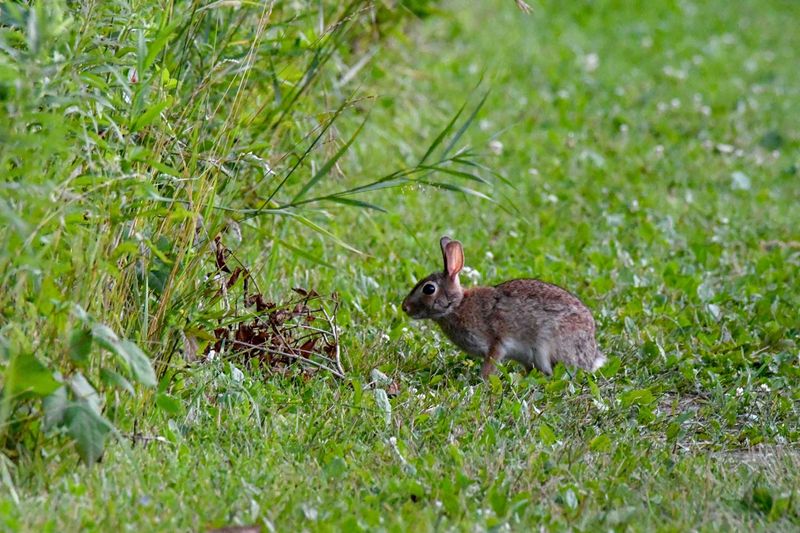
In the meadows of Illinois, the eastern cottontail rabbit is a symbol of speed and agility. Capable of reaching speeds up to 18 mph, this small mammal uses its powerful hind legs to dart away from predators.
The eastern cottontail rabbit’s keen senses and quick reflexes make it a master of evasion, thriving in the open grasslands of Illinois. Observing these rabbits in their natural habitat reveals the intricate dance between predator and prey, where speed is essential for survival.
Their presence in Illinois is vital for the ecosystem, as they serve as prey for larger animals and help control plant growth through grazing. The eastern cottontail rabbit’s speed and resourcefulness make it a beloved figure in the state’s wildlife, embodying the delicate balance of nature.
Their quick movements and endearing appearance capture the hearts of those who witness them, highlighting the charm of Illinois’ natural landscapes.
30. Wisconsin – American Badger
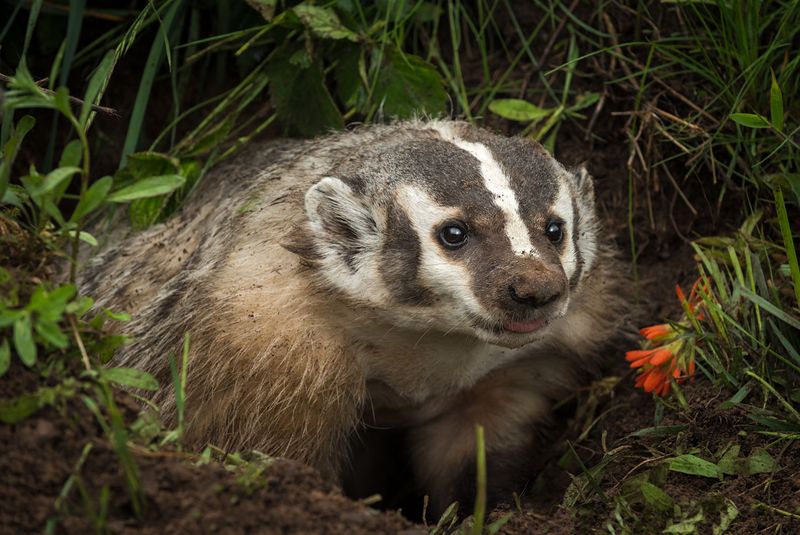
In the prairies of Wisconsin, the American badger is a creature of speed and tenacity. Capable of running at speeds up to 15 mph, this burrowing mammal is known for its strength and resilience.
The American badger’s powerful claws and sturdy build allow it to dig quickly, creating burrows for shelter and hunting. In Wisconsin, these badgers are a vital part of the ecosystem, controlling rodent populations and aerating the soil.
Observing an American badger in its natural habitat offers a glimpse into the tough, gritty life of this fascinating animal.
Their presence highlights the importance of maintaining prairie habitats, where they play a crucial role in ecological balance. The American badger’s speed and determination make it a symbol of perseverance in Wisconsin’s wildlife.
Their ability to adapt and thrive in challenging environments is a testament to nature’s ingenuity, captivating those who encounter them in the wild.
31. Arkansas – White-Tailed Deer
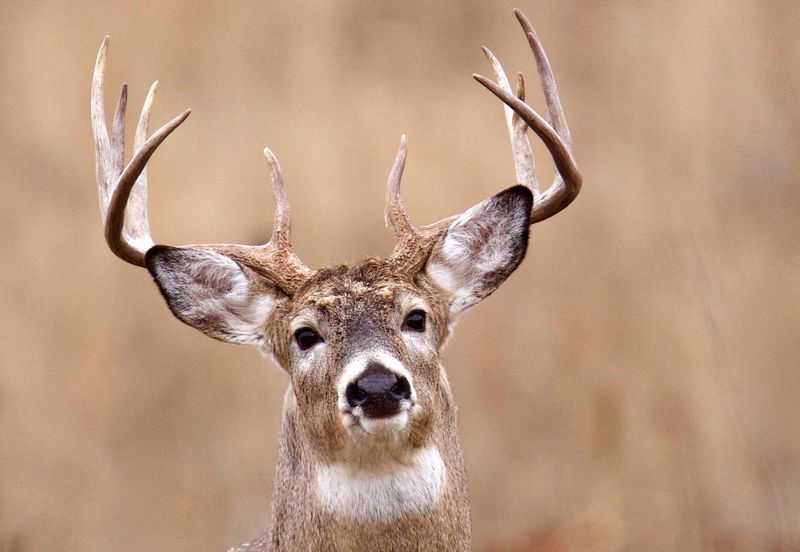
In the forests of Arkansas, the white-tailed deer is a symbol of speed and grace. Capable of reaching speeds up to 40 mph, this agile creature navigates the dense woodlands with ease.
The white-tailed deer’s powerful legs and keen senses are vital for evading predators and foraging for food. In Arkansas, these deer are a common sight, their white tails flashing as they move through the underbrush.
Observing a white-tailed deer in its natural habitat is a glimpse into the delicate balance of nature, where speed is both a defense mechanism and a way of life. Their role in the ecosystem is essential, as they help control plant growth and provide prey for larger carnivores.
The white-tailed deer’s speed and agility highlight the dynamic beauty of Arkansas’ natural landscapes, making them a cherished symbol of the state’s wildlife and a fascinating subject for nature enthusiasts.
32. Missouri – Eastern Gray Squirrel
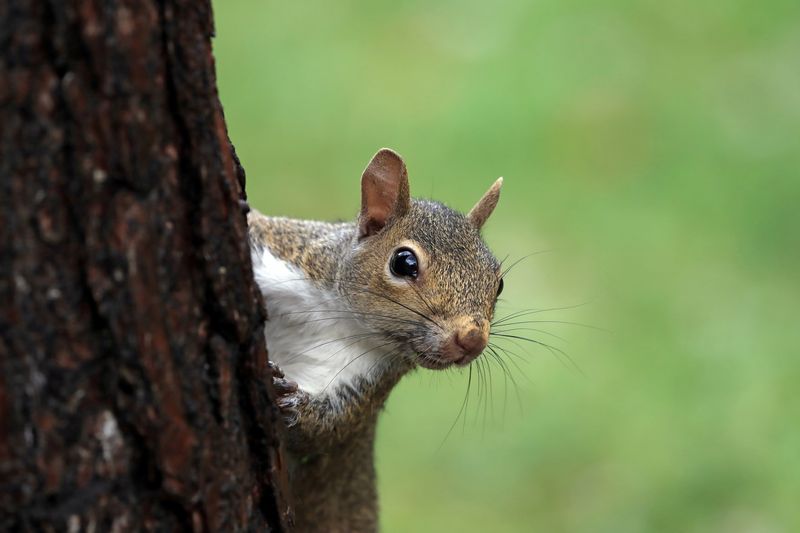
In the forests of Missouri, the eastern gray squirrel is a lively symbol of speed and agility. Capable of reaching speeds up to 20 mph, this small mammal is a master of acrobatics among the trees.
The eastern gray squirrel’s powerful hind legs and keen senses enable it to leap significant distances, evading predators and gathering food. In Missouri, these squirrels are a common sight, their playful antics and bushy tails adding charm to the natural landscape.
Observing an eastern gray squirrel in its natural habitat is a lesson in agility, showcasing nature’s adaptability and resourcefulness. Their speed is not only for escaping threats but also for storing food and building nests.
The presence of eastern gray squirrels highlights the importance of maintaining healthy forest ecosystems, where they play a crucial role in seed dispersal. Their quick movements and curious nature make them a delightful part of Missouri’s wildlife.
33. Iowa – Pronghorn
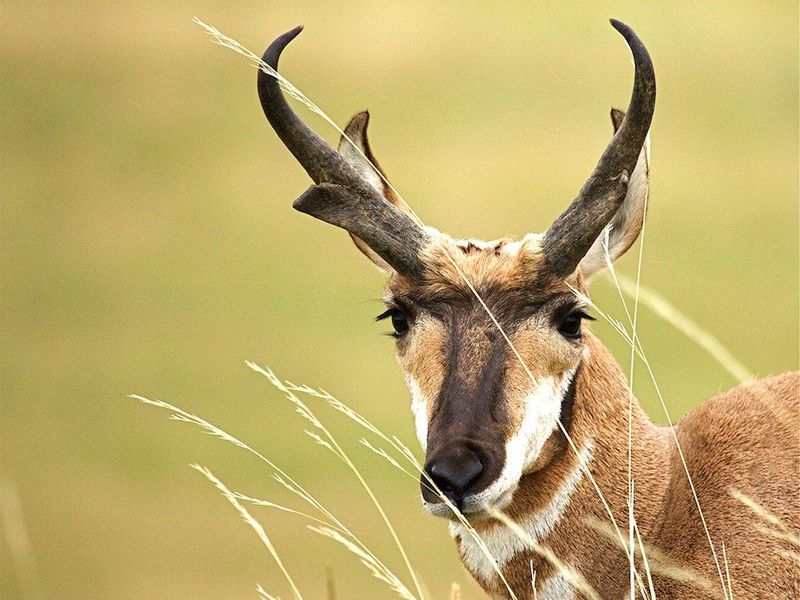
In the open plains of Iowa, the pronghorn is a creature of speed and agility. Capable of reaching speeds up to 55 mph, this remarkable animal is the fastest land mammal in North America. The pronghorn’s speed is an evolutionary advantage, allowing it to outrun predators across vast distances.
Its unique anatomy, characterized by large lungs and a powerful cardiovascular system, supports its high-speed sprints. In Iowa, pronghorns are a rare sight, their presence adding to the state’s diverse wildlife.
Observing a pronghorn in motion is a testament to nature’s engineering, with every stride optimized for speed and endurance. Their role in the ecosystem is vital, as they graze on native grasses and serve as prey for larger carnivores.
The pronghorn’s incredible speed and grace make it a symbol of the untamed beauty of Iowa’s landscapes, captivating all who witness its fleeting elegance.
34. Nebraska – Swift Fox
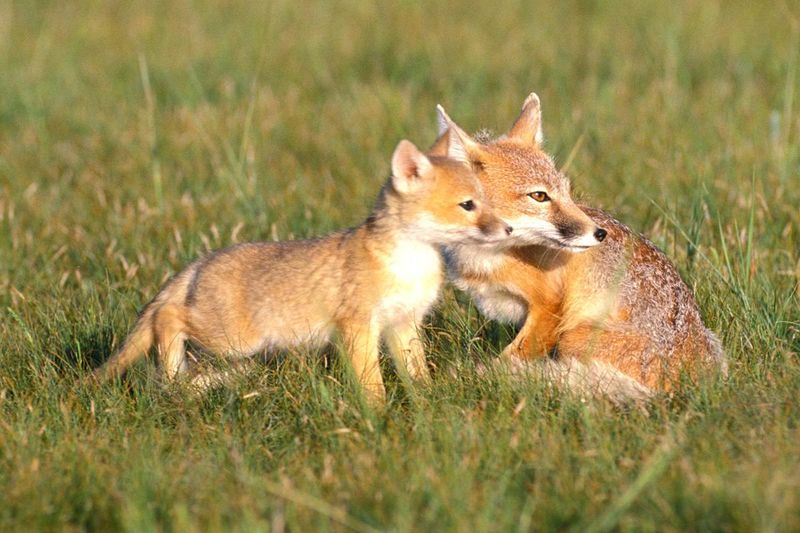
In the grasslands of Nebraska, the swift fox is a creature of speed and agility. Capable of reaching speeds up to 31 mph, this small predator is adept at navigating the open prairies. The swift fox’s slender build and keen senses make it a proficient hunter, preying on small mammals and insects.
In Nebraska, these foxes play a crucial role in controlling rodent populations and maintaining ecological balance. Observing a swift fox in its natural habitat is a glimpse into the intricate web of life, where speed and cunning are essential for survival.
Their presence highlights the importance of preserving prairie habitats, where they thrive amid the open expanses.
The swift fox’s speed and agility make it a fascinating subject for wildlife enthusiasts, embodying the wild spirit of Nebraska’s landscapes. Their ability to adapt and thrive in challenging environments is a testament to nature’s ingenuity, captivating those who encounter them in the wild.
35. Kansas – Greater Prairie Chicken
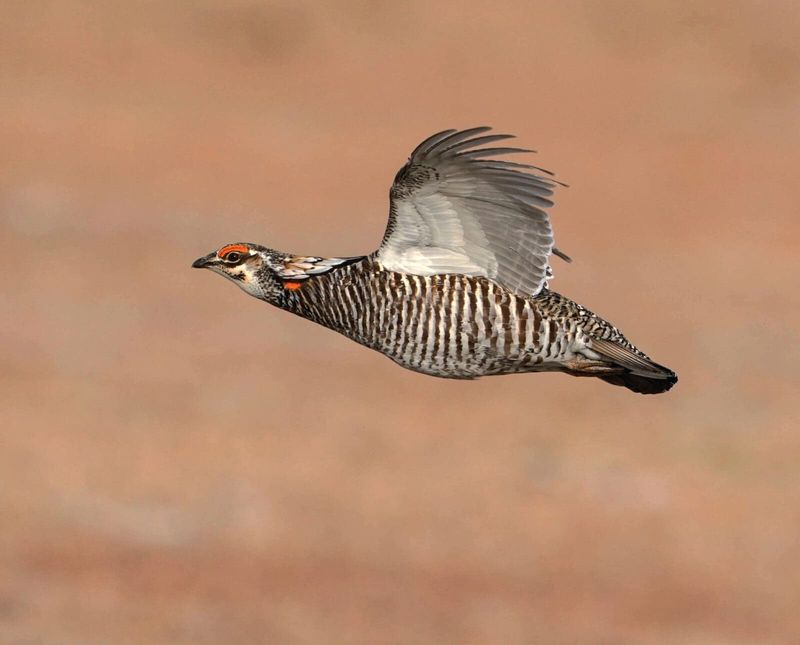
In the grasslands of Kansas, the greater prairie chicken is a symbol of speed and grace. Capable of running at speeds up to 10 mph, this bird is known for its unique courtship displays and vibrant plumage.
The greater prairie chicken’s strong legs and keen senses enable it to navigate the open plains, evading predators and foraging for food. In Kansas, these birds are a vital part of the ecosystem, helping to control insect populations and disperse seeds.
Observing a greater prairie chicken in its natural habitat is a fascinating glimpse into the intricate dance of life, where speed and agility are essential for survival. Their presence highlights the importance of preserving grassland habitats, where they thrive amid the open expanses.
The greater prairie chicken’s speed and vibrancy make it a captivating figure in Kansas’ wildlife, embodying the wild spirit of the state’s landscapes. Their role in the ecosystem is vital, and their colorful displays continue to inspire awe and admiration.
36. South Dakota – Swift Fox
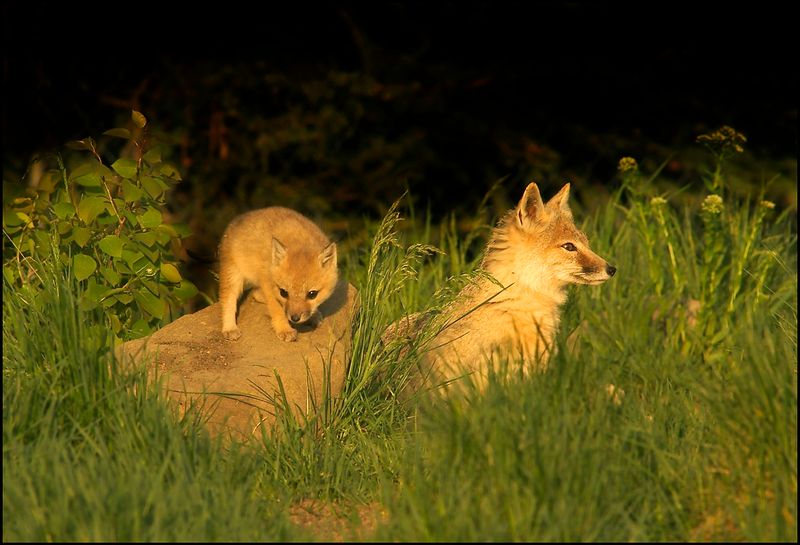
In the plains of South Dakota, the swift fox is a creature of speed and cunning. Capable of reaching speeds up to 31 mph, this small predator navigates the grasslands with agility and stealth. The swift fox’s slender build and sharp senses make it an adept hunter, preying on small mammals and birds.
In South Dakota, these foxes play a crucial role in controlling rodent populations and maintaining ecological balance. Observing a swift fox in its natural habitat is a glimpse into the intricate web of life, where speed and cunning are essential for survival.
Their presence highlights the importance of preserving prairie habitats, where they thrive amid the open expanses.
The swift fox’s speed and agility make it a fascinating subject for wildlife enthusiasts, embodying the wild spirit of South Dakota’s landscapes. Their ability to adapt and thrive in challenging environments is a testament to nature’s ingenuity, captivating those who encounter them in the wild.
37. North Carolina – White-Tailed Deer
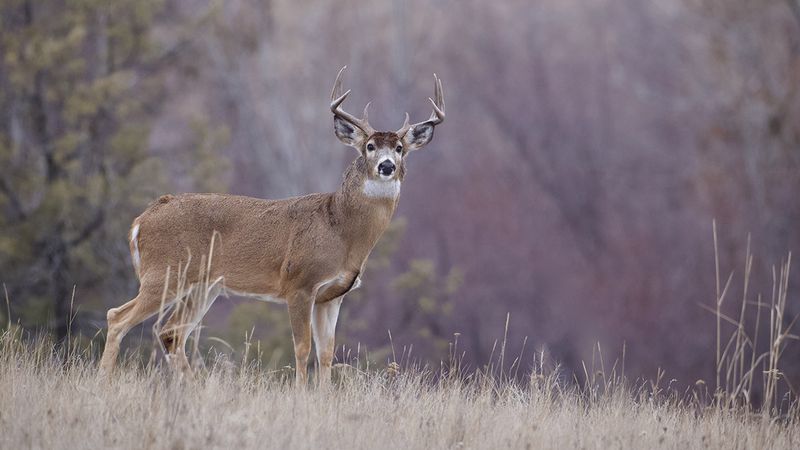
In the forests of North Carolina, the white-tailed deer is a symbol of speed and grace. Capable of reaching speeds up to 40 mph, this agile creature navigates the dense woodlands with ease. The white-tailed deer’s powerful legs and keen senses are vital for evading predators and foraging for food.
In North Carolina, these deer are a common sight, their white tails flashing as they move through the underbrush. Observing a white-tailed deer in its natural habitat is a glimpse into the delicate balance of nature, where speed is both a defense mechanism and a way of life.
Their role in the ecosystem is essential, as they help control plant growth and provide prey for larger carnivores.
The white-tailed deer’s speed and agility highlight the dynamic beauty of North Carolina’s natural landscapes, making them a cherished symbol of the state’s wildlife and a fascinating subject for nature enthusiasts.
38. South Carolina – Loggerhead Sea Turtle
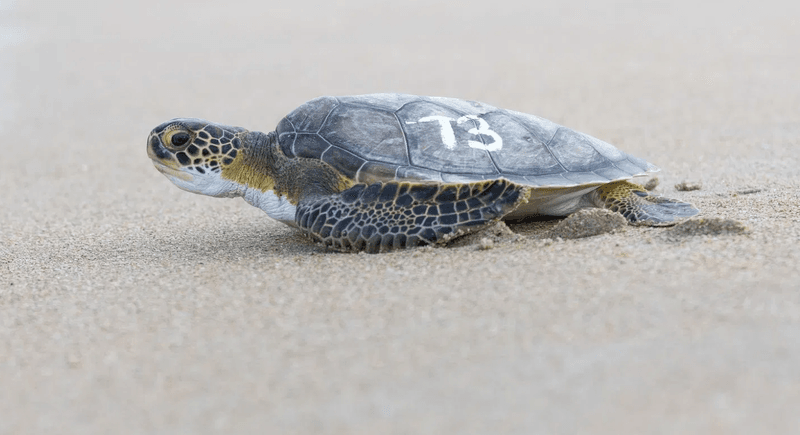
In the coastal waters of South Carolina, the loggerhead sea turtle is a symbol of endurance and grace. Known for its long migrations, this marine reptile can reach speeds up to 15 mph in the water. The loggerhead’s powerful flippers and streamlined shell enable it to navigate the ocean with ease, covering vast distances in search of food and nesting sites.
In South Carolina, these turtles are a vital part of the marine ecosystem, helping to maintain the health of seagrass beds and coral reefs.
Observing a loggerhead sea turtle in its natural habitat is a mesmerizing experience, highlighting the beauty and complexity of marine life. Their presence underscores the importance of conservation efforts to protect these ancient creatures and their habitats.
The loggerhead sea turtle’s speed and resilience make it a beloved icon of South Carolina’s coastal heritage, inspiring awe and respect for the natural world.
39. Virginia – Eastern Cottontail Rabbit
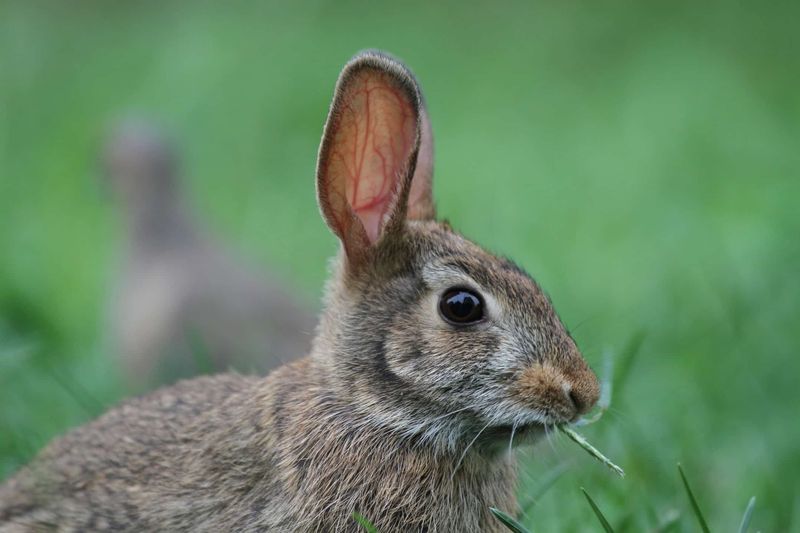
In the meadows of Virginia, the eastern cottontail rabbit is a symbol of speed and agility. Capable of reaching speeds up to 18 mph, this small mammal uses its powerful hind legs to dart away from predators.
The eastern cottontail rabbit’s keen senses and quick reflexes make it a master of evasion, thriving in the open grasslands of Virginia. Observing these rabbits in their natural habitat reveals the intricate dance between predator and prey, where speed is essential for survival.
Their presence in Virginia is vital for the ecosystem, as they serve as prey for larger animals and help control plant growth through grazing.
The eastern cottontail rabbit’s speed and resourcefulness make it a beloved figure in the state’s wildlife, embodying the delicate balance of nature. Their quick movements and endearing appearance capture the hearts of those who witness them, highlighting the charm of Virginia’s natural landscapes.
40. West Virginia – Black Bear
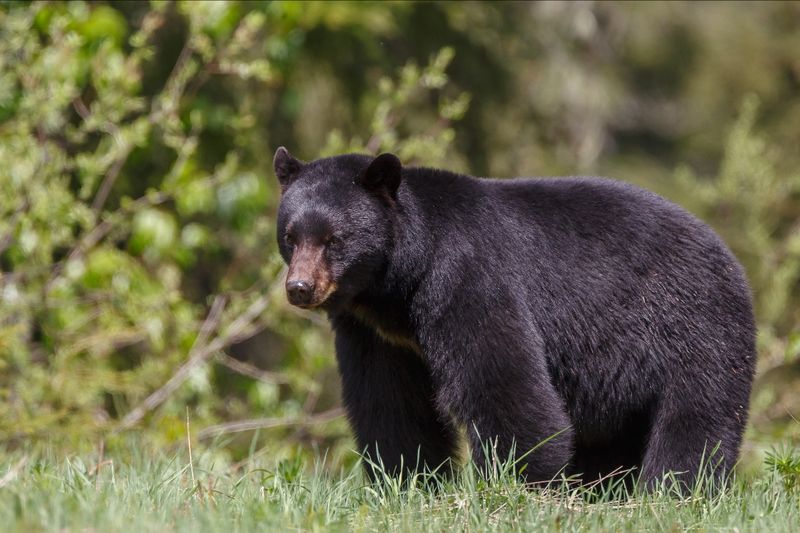
In the dense forests of West Virginia, the black bear is a symbol of strength and speed. Capable of reaching speeds up to 30 mph, this large mammal is both powerful and agile. The black bear’s sturdy build and keen senses make it a proficient forager, navigating the forests in search of food.
In West Virginia, these bears play a vital role in the ecosystem, helping to control prey populations and disperse seeds. Observing a black bear in its natural habitat is a humbling experience, showcasing the majestic power of the wild.
Their presence highlights the importance of conserving forest habitats, where they thrive amid the diverse flora and fauna.
The black bear’s speed and strength make it a fascinating subject for wildlife enthusiasts, embodying the untamed essence of West Virginia’s landscapes. Their ability to adapt and survive in challenging environments is a testament to nature’s resilience, captivating those who encounter them in the wild.
41. Maryland – Peregrine Falcon
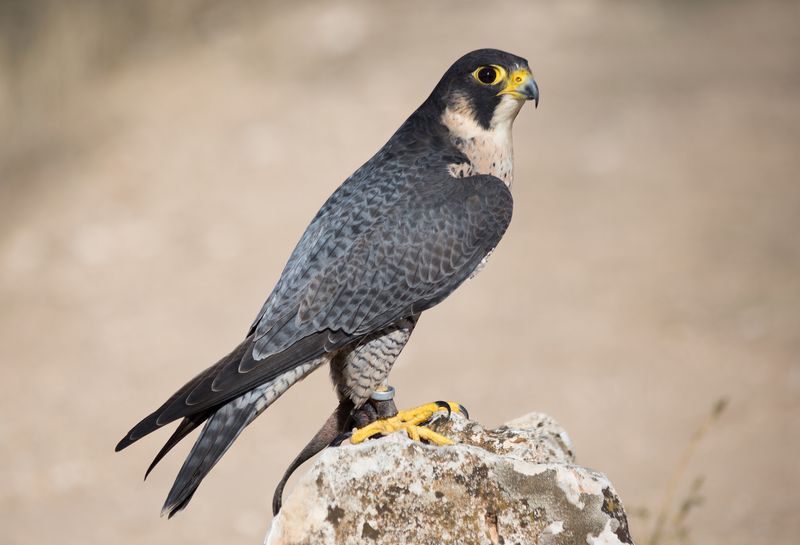
In Maryland, the peregrine falcon stands out as a symbol of speed and precision. Known for its breathtaking dives that can exceed 240 mph, this bird of prey dominates the skies over the Chesapeake Bay.
The peregrine falcon’s streamlined body and keen eyesight make it a formidable hunter, often seen swooping down on unsuspecting prey.
Their presence in Maryland is a testament to the state’s conservation efforts, as peregrine populations have rebounded in recent years. Observing a peregrine falcon in action is an awe-inspiring experience, a reminder of nature’s incredible adaptability and power.
Their speed and agility make them one of the most admired birds in the avian world, embodying the spirit of freedom and grace. The peregrine falcon’s role in Maryland’s ecosystem is vital, illustrating the delicate balance of predator and prey interactions, and the ongoing commitment to preserving the state’s natural heritage.
42. Delaware – Bald Eagle
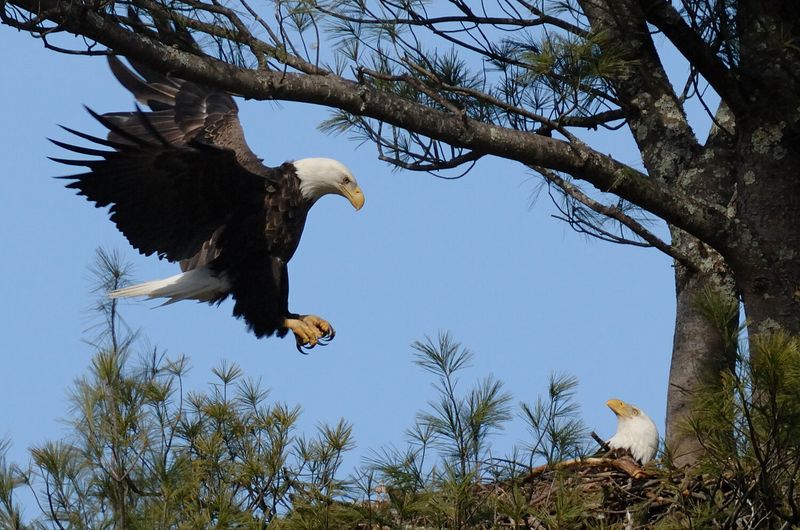
In the coastal marshes of Delaware, the bald eagle is a symbol of strength and speed. Known for its hunting prowess, this bird of prey can reach speeds up to 100 mph during its dives.
The bald eagle’s distinctive white head and tail make it a recognizable icon of American wildlife, often seen gliding over the state’s waterways. In Delaware, these eagles play a vital role in the ecosystem, preying on fish and maintaining the health of aquatic habitats.
Observing a bald eagle in flight is a powerful experience, capturing the majesty and freedom of the natural world. Their presence underscores the importance of conservation efforts to protect these majestic birds and their habitats.
The bald eagle’s speed and precision in hunting make it an admired and respected figure in Delaware’s wildlife, embodying the resilience and beauty of the state’s diverse ecosystems.
43. New Jersey – White-Tailed Deer
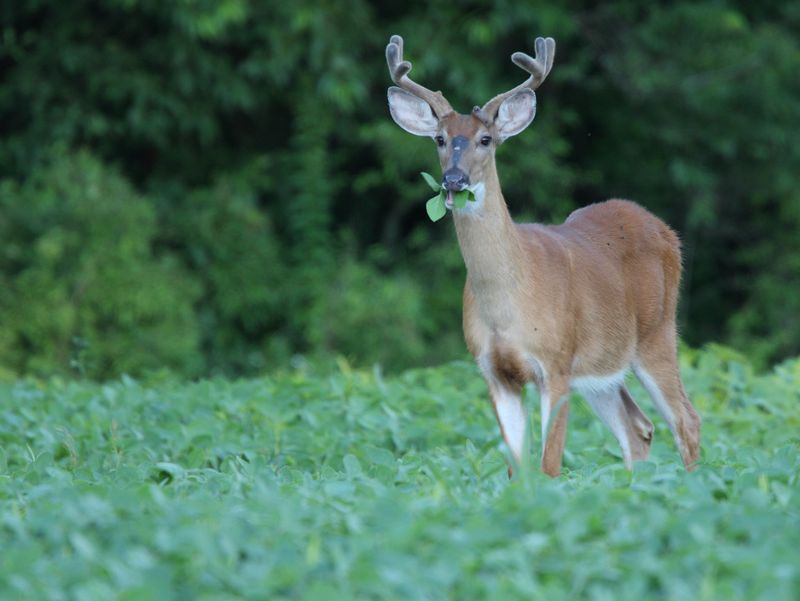
In the forests of New Jersey, the white-tailed deer is a symbol of speed and grace. Capable of reaching speeds up to 40 mph, this agile creature navigates the dense woodlands with ease. The white-tailed deer’s powerful legs and keen senses are vital for evading predators and foraging for food.
In New Jersey, these deer are a common sight, their white tails flashing as they move through the underbrush. Observing a white-tailed deer in its natural habitat is a glimpse into the delicate balance of nature, where speed is both a defense mechanism and a way of life.
Their role in the ecosystem is essential, as they help control plant growth and provide prey for larger carnivores. The white-tailed deer’s speed and agility highlight the dynamic beauty of New Jersey’s natural landscapes, making them a cherished symbol of the state’s wildlife and a fascinating subject for nature enthusiasts.
44. Pennsylvania – Peregrine Falcon
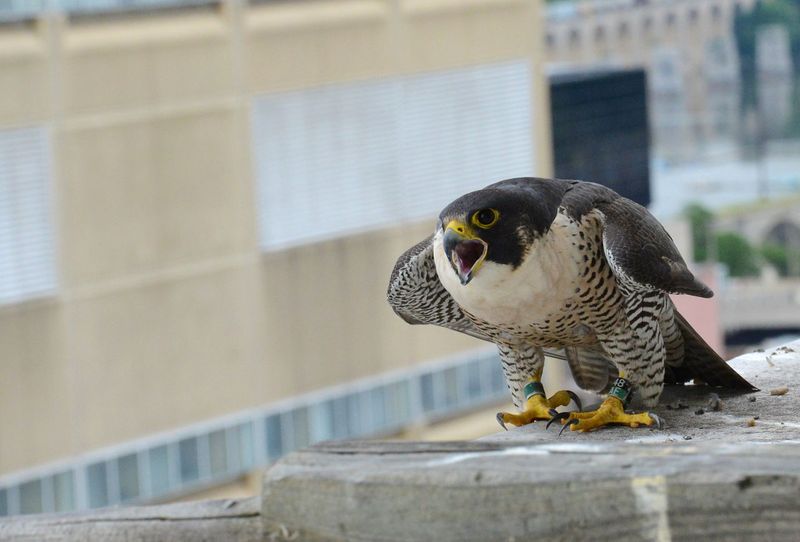
In Pennsylvania, the peregrine falcon is a master of speed and precision. Known for its record-breaking dives that can reach over 240 mph, this bird of prey commands the skies with unparalleled agility. The peregrine falcon’s streamlined body and keen eyesight make it a formidable hunter, often seen swooping down on unsuspecting prey in the countryside.
Their presence in Pennsylvania is a testament to successful conservation efforts, as peregrine populations have rebounded significantly.
Observing a peregrine falcon in action is a breathtaking experience, showcasing the raw power and grace of nature’s design. Their speed and adaptability make them one of the most admired birds in the avian world, embodying the spirit of freedom and grace.
The peregrine falcon’s role in Pennsylvania’s ecosystem is vital, illustrating the delicate balance of predator and prey interactions, and highlighting the ongoing commitment to preserving the state’s natural heritage.
45. Connecticut – Red Fox
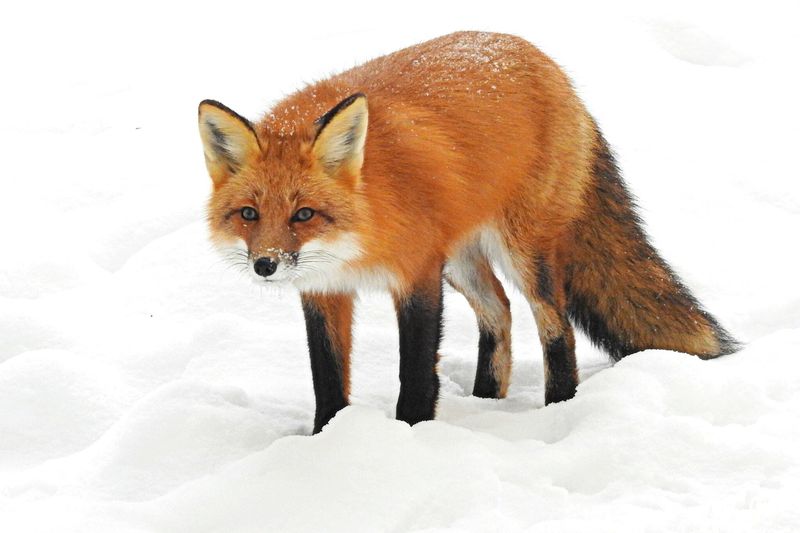
In the woodlands of Connecticut, the red fox is a symbol of speed and cunning. Known for its ability to reach speeds up to 29 mph, this agile predator uses its swiftness to hunt small mammals and birds.
The red fox’s striking red coat and bushy tail provide camouflage among the forest’s foliage, aiding in its stealthy approach. In Connecticut, these foxes are a common sight, their keen senses and adaptability allowing them to thrive in various environments.
Observing a red fox in its natural habitat is a lesson in survival, showcasing the intricate balance of predator and prey. Their speed is not only crucial for hunting but also for evading larger predators.
The red fox’s presence in Connecticut highlights the importance of preserving natural habitats to maintain biodiversity. Their grace and agility make them a fascinating subject for wildlife enthusiasts, embodying the wild spirit of the state’s landscapes.
46. Rhode Island – Osprey
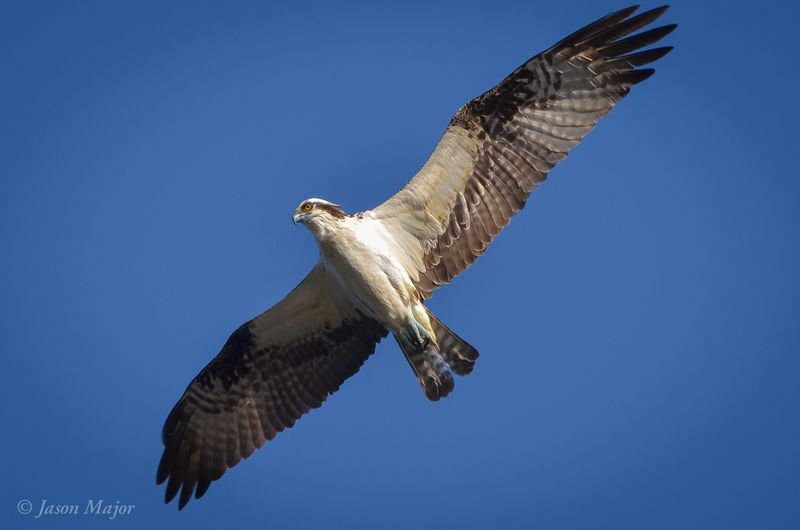
In the coastal regions of Rhode Island, the osprey is a symbol of speed and precision. Known for its dramatic dives, this bird of prey can reach speeds up to 80 mph as it plunges into the water to catch fish.
The osprey’s keen eyesight and powerful talons make it a formidable hunter, often seen soaring above the state’s waterways. In Rhode Island, these birds play a vital role in the ecosystem, helping to control fish populations and maintain the health of aquatic habitats.
Observing an osprey in action is a thrilling experience, capturing the majesty and grace of the natural world. Their presence underscores the importance of conservation efforts to protect these majestic birds and their habitats.
The osprey’s speed and agility in hunting make it an admired figure in Rhode Island’s wildlife, embodying the resilience and beauty of the state’s diverse ecosystems.
47. Massachusetts – Eastern Cottontail Rabbit
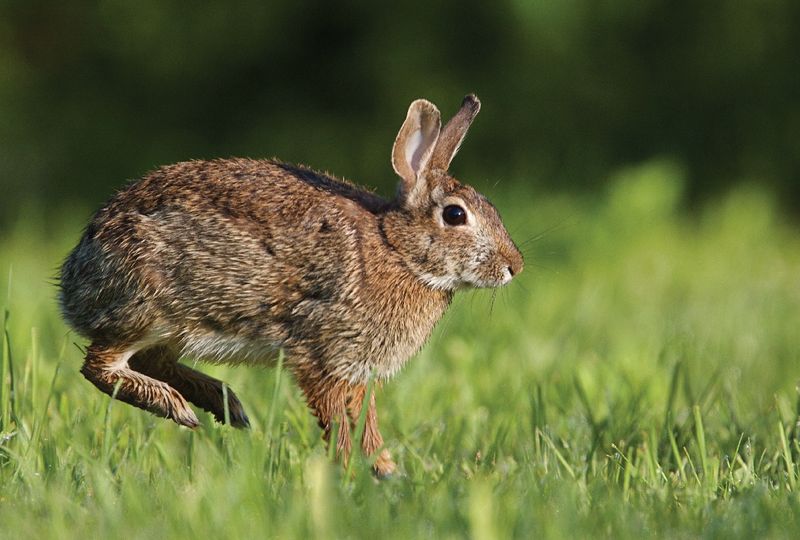
In the meadows of Massachusetts, the eastern cottontail rabbit is a symbol of speed and agility. Capable of reaching speeds up to 18 mph, this small mammal uses its powerful hind legs to dart away from predators.
The eastern cottontail rabbit’s keen senses and quick reflexes make it a master of evasion, thriving in the open grasslands of Massachusetts. Observing these rabbits in their natural habitat reveals the intricate dance between predator and prey, where speed is essential for survival.
Their presence in Massachusetts is vital for the ecosystem, as they serve as prey for larger animals and help control plant growth through grazing.
The eastern cottontail rabbit’s speed and resourcefulness make it a beloved figure in the state’s wildlife, embodying the delicate balance of nature. Their quick movements and endearing appearance capture the hearts of those who witness them, highlighting the charm of Massachusetts’ natural landscapes.
48. Vermont – White-Tailed Deer
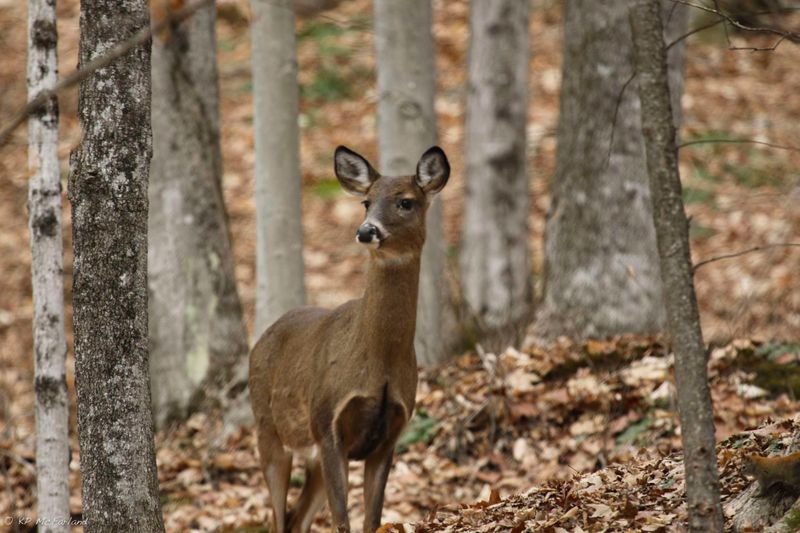
In the forests of Vermont, the white-tailed deer is a symbol of speed and grace. Capable of reaching speeds up to 40 mph, this agile creature navigates the dense woodlands with ease. The white-tailed deer’s powerful legs and keen senses are vital for evading predators and foraging for food.
In Vermont, these deer are a common sight, their white tails flashing as they move through the underbrush. Observing a white-tailed deer in its natural habitat is a glimpse into the delicate balance of nature, where speed is both a defense mechanism and a way of life.
Their role in the ecosystem is essential, as they help control plant growth and provide prey for larger carnivores. The white-tailed deer’s speed and agility highlight the dynamic beauty of Vermont’s natural landscapes, making them a cherished symbol of the state’s wildlife and a fascinating subject for nature enthusiasts.
49. New Hampshire – Snowshoe Hare
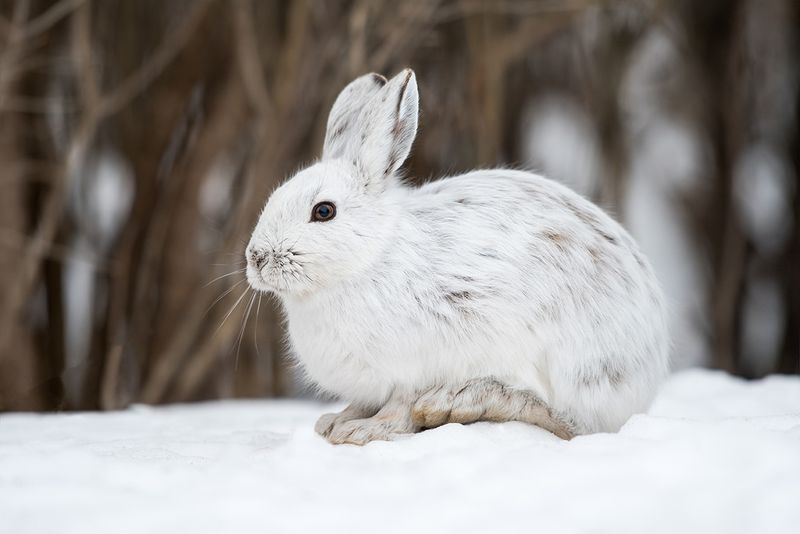
In the snowy forests of New Hampshire, the snowshoe hare is a master of speed and camouflage. Capable of reaching speeds up to 30 mph, this small mammal uses its powerful hind legs to evade predators. The snowshoe hare’s large feet are adapted for moving across snow, allowing it to navigate the winter landscape with ease.
In New Hampshire, these hares are a vital part of the ecosystem, serving as prey for larger predators and helping to control vegetation through grazing. Observing a snowshoe hare in its natural habitat reveals the intricate balance of survival, where speed and stealth are essential.
Their presence highlights the importance of maintaining healthy forest ecosystems, where they play a crucial role in the food chain. The snowshoe hare’s speed and adaptability make it a beloved figure in New Hampshire’s wildlife, embodying the resilience and beauty of nature in the harsh winter months.
50. Maine – Canada Lynx
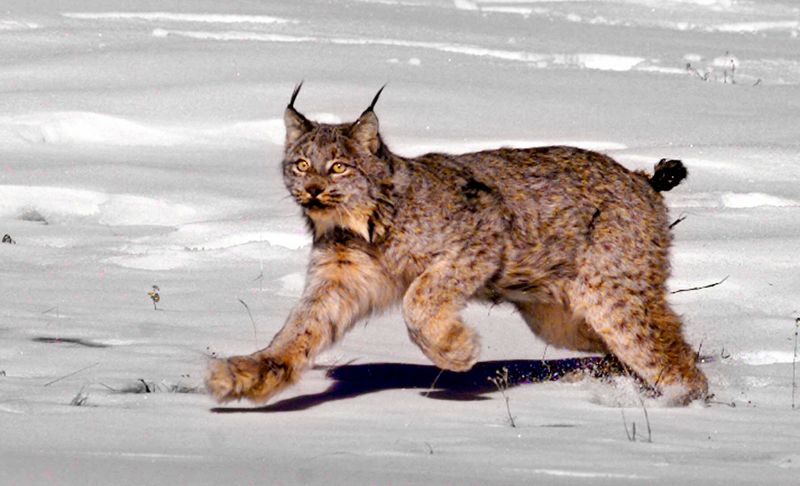
In the dense forests of Maine, the Canada lynx is a symbol of stealth and speed. Capable of reaching speeds up to 50 mph in short bursts, this elusive predator is a master of hunting in snowy environments.
The Canada lynx’s long legs and large paws are adapted for moving silently across snow, allowing it to stalk prey with precision. In Maine, these lynx play a crucial role in controlling hare populations and maintaining ecological balance.
Observing a Canada lynx in its natural habitat is a rare and awe-inspiring experience, showcasing the power and grace of this remarkable animal. Their presence highlights the importance of conserving forest habitats, where they thrive amid the diverse flora and fauna.
The Canada lynx’s speed and agility make it a fascinating subject for wildlife enthusiasts, embodying the untamed essence of Maine’s landscapes. Their ability to adapt and survive in challenging environments is a testament to nature’s resilience, captivating those who encounter them in the wild.


